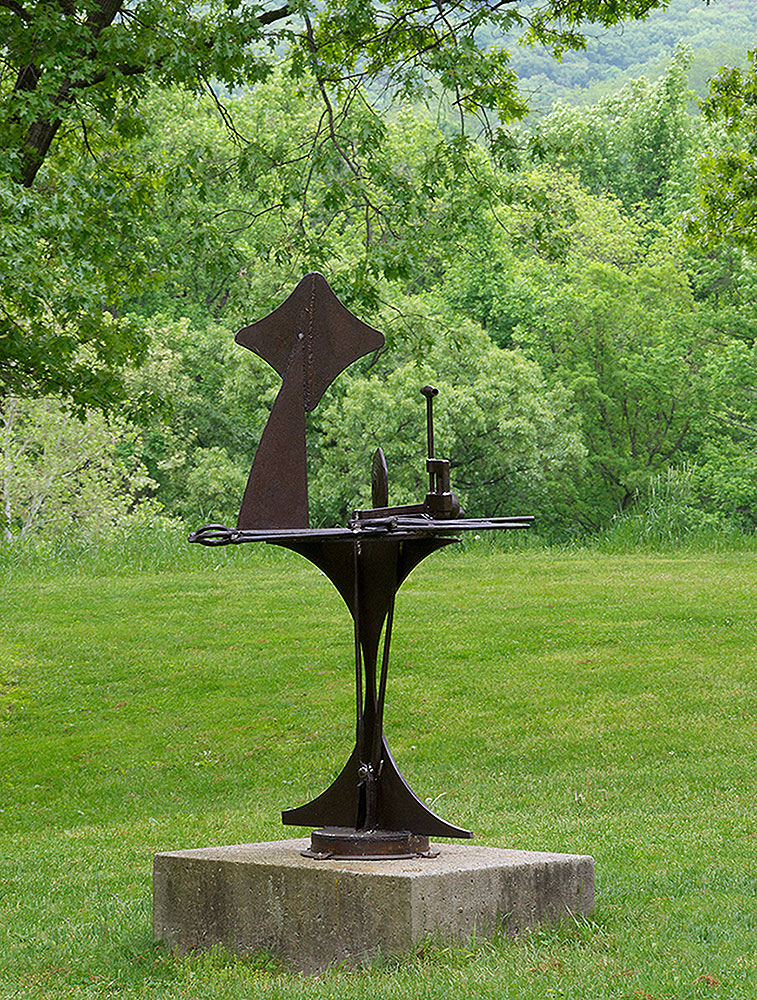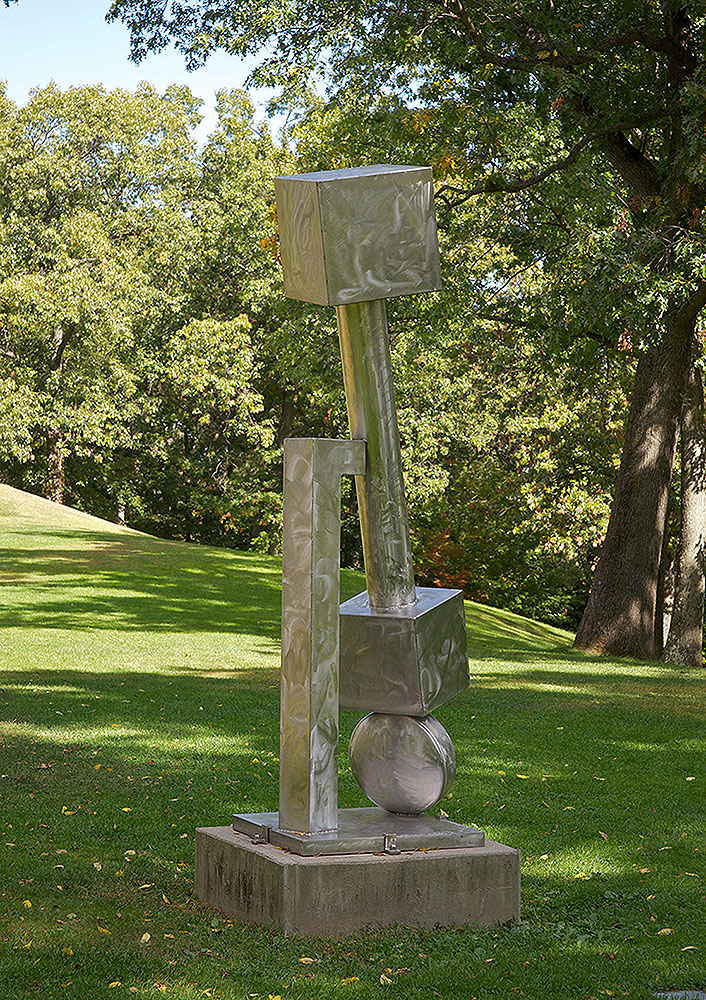
“Primo Piano I”, 1962
Painted steel
110 x 144 x 21 in. (279.4 x 365.8 x 53.3 cm)
Roberts Family Collection
Beginning in the early 1950s, Smith often worked in series, modifying the compositional elements of each iteration within a sculptural group. In explaining the significance of the title of his Primo Piano series, the artist said: “This group [is] called Primo Piano, only because on the first floor nothing happens—whatever takes place is on the second floor.” Primo Piano I, which typifies the geometric flatness characteristic of the series, creates moments of visual framing through cutouts, angular junctions, and enclosed negative space. This exhibition marks the first time the three works in the series have been displayed as a group.

“Primo Piano II”, 1962
Painted steel, stainless steel, and bronze
85 x 158 x 15 in. (215.9 x 401.3 x 38.1 cm)
The Estate of David Smith, New York; courtesy Hauser & Wirth
In Primo Piano II, a bare teardrop shape cut from industrial bronze plate contrasts with painted white surfaces, demonstrating Smith’s frequent interest in both textural and color differences within a sculpture’s overall composition. The artist sometimes spoke of white paint as a “primer” for later applications of color, although white was not always the base coat; Smith often layered yellow, green, and even red paint on his works before applying one or more additional coats of white. Leaving the sculptures white while he contemplated their final color, the artist would install the works outdoors, sometimes waiting months or even years before determining that a piece was finished.

“Primo Piano III”, 1962
Painted steel
124 x 146 x 19 in. (315 x 370.8 x 48.3 cm)
The Estate of David Smith, New York; courtesy Hauser & Wirth
Smith took great care installing his sculptures in groups in the fields surrounding his Adirondack studio in Bolton Landing, NY, in conversation with the mountainous landscape. Primo Piano III, the last in the Primo Piano series, with its flat array of three simple and assertive geometric forms supported along a sturdy horizontal, creates a visual “cutout” in the landscape. Smith was interested in breaking down the distinctions between painting and sculpture. The white sculptures, like Primo Piano III, create in three-dimensions the inversion of figure and ground that he was also exploring in his spray enamel paintings, some of which are displayed in the museum building. This dramatic effect is seen when viewing these works installed outdoors, a viewshed which closely approximates Smith’s own installation of the white sculptures on his property at Bolton Landing.

Circle and Box (Circle and Ray), 1963
Painted steel
119 1/2 x 29 1/4 x 22 ½ in. (303.5 x 74.3 x 57.2 cm)
Irma and Norman Braman Art Foundation, Florida
Smith acquired his welding skills as a young man by working in the Studebaker automobile factory in South Bend, Indiana, and he later assembled locomotives and destroyer tankers in Schenectady, New York, during World War II. Drawn to the materials and techniques of machine welding, Smith often used industrial automobile enamels to paint his works. In Circle and Box (Circle and Ray) disparate elements that reflect Smith’s experience in industrial metalsmithing are welded together to form a collage-like composition, which the artist then unified with monochrome coats of white paint.
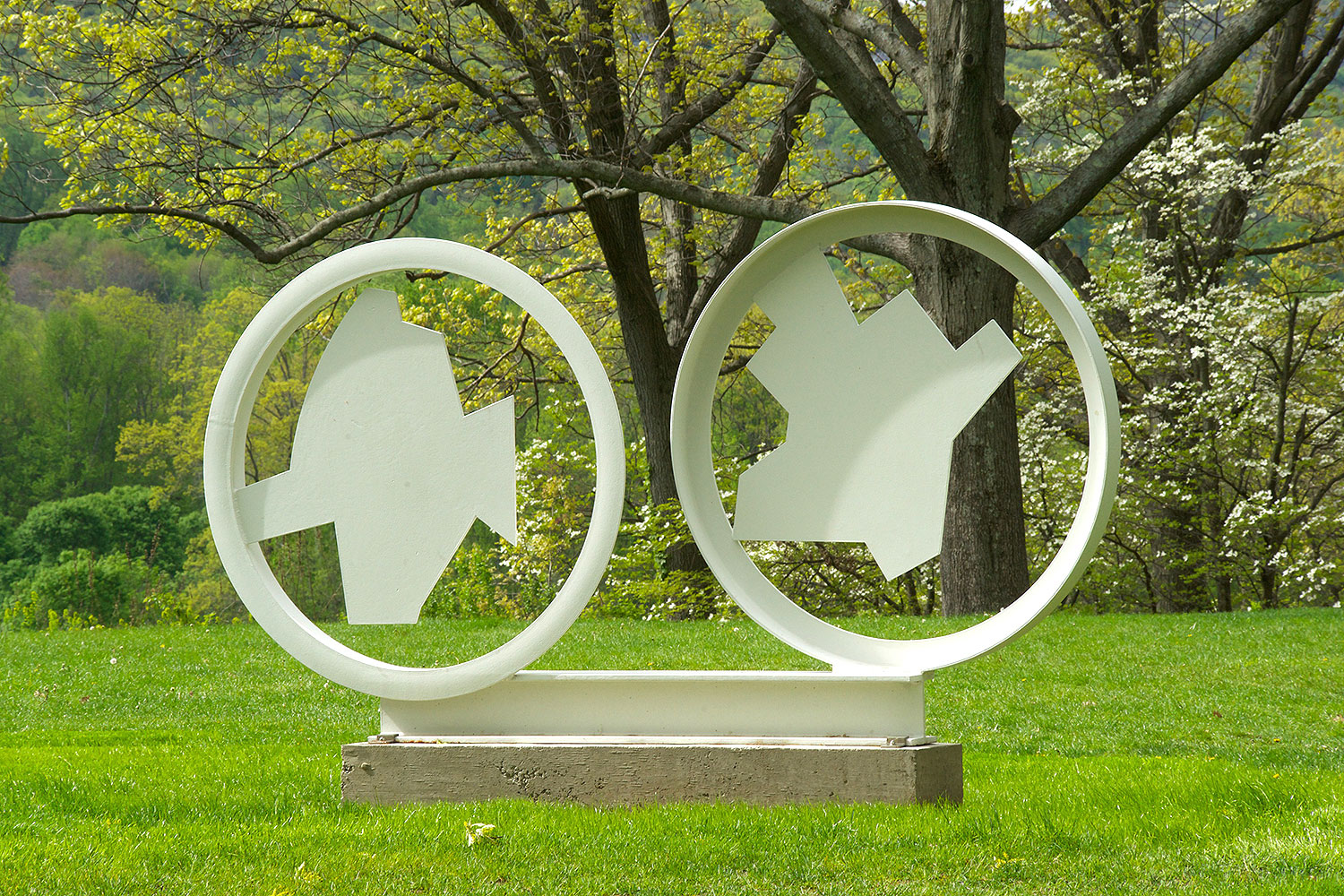
2 Circles 2 Crows, 1963
Painted steel
68 3/4 x 125 x 8 1/4 in. (174.6 x 317.5 x 21.0 cm)
Irma and Norman Braman Art Foundation, Florida
Smith once said that his sculptures “can begin sometimes when I’m sweeping the floor and I stumble and kick a few parts that happen to throw into an alignment that . . . sets off a vision of how it would finish if it all had that kind of accidental beauty to it. I want to be like a poet, in a sense.” In 2 Circles 2 Crows, two found metal circles frame cutout scraps from another work (2 Circle IV, 1962), which became the titular elements seen here. This work celebrates the discrepancies in repetition between the two forms, while exemplifying the artist’s interest in combining found elements to compose a singular sculpture.
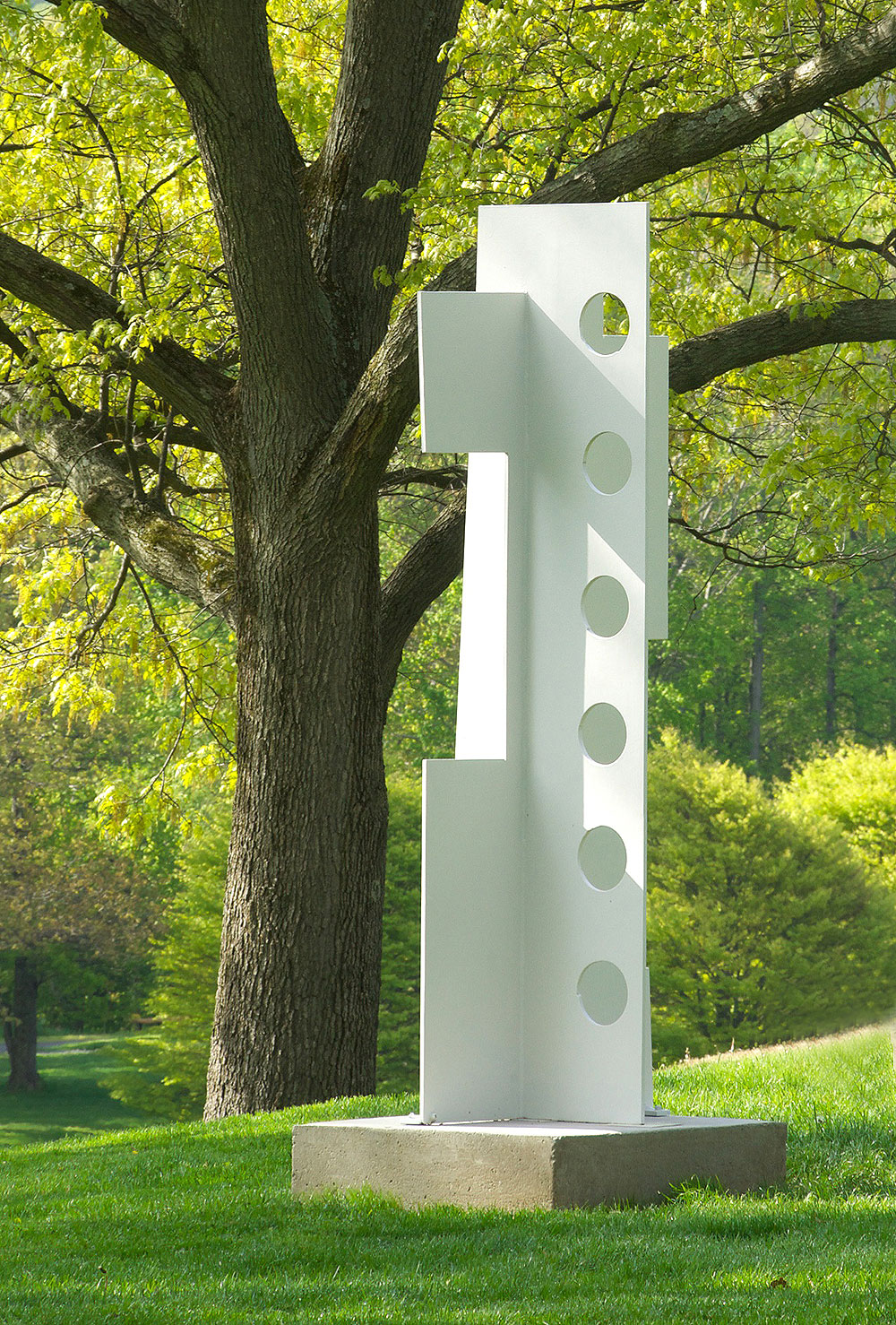
Untitled, 1963
Painted steel
88 x 33 x 26 in. (223.5 x 83.8 x 66 cm)
Collection of Candida Smith; courtesy the Estate of David Smith, New York
This untitled work invites the viewer to walk around the sculpture, directing an experience that incorporates the landscape and the movements of the viewer. The four planar sections, set perpendicular to one another, appear, disappear, and reappear as they are foreshortened or hidden depending on the viewer’s position—revealing rectangular incisions and circular cutouts that frame unexpected vistas. The sculpture’s construction precludes viewing all four planes simultaneously; only in the viewer’s imagination can the work be seen in its entirety.
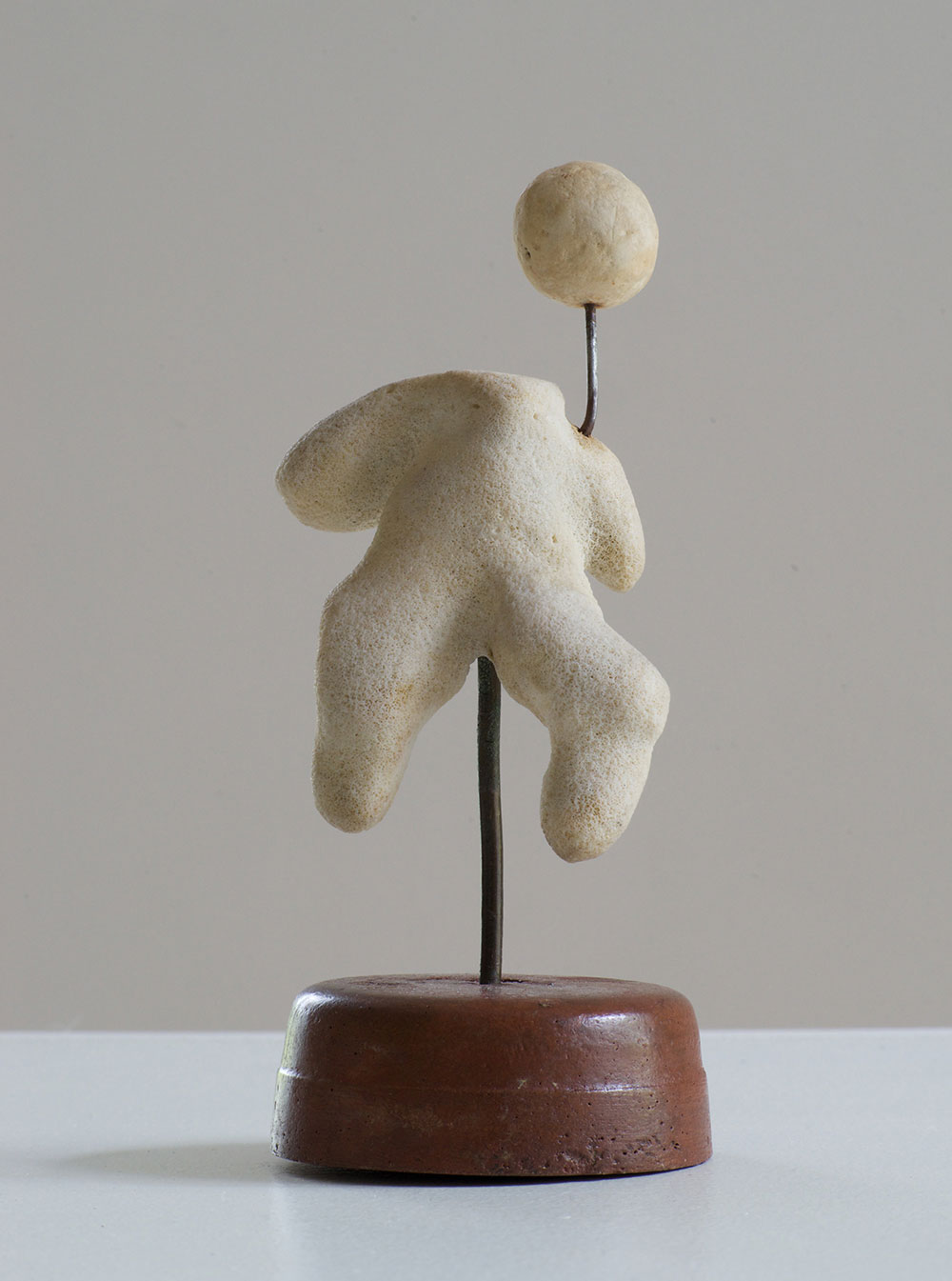
Untitled (Standing Figure), 1932
Coral and wire on terra cotta base
5 5/8 x 2 1/2 x 2 1/2 in. (14.3 x 6.4 x 6.4 cm)
The Estate of David Smith, New York; courtesy Hauser & Wirth
From October 1931 to June 1932, Smith and his first wife, Dorothy Dehner, a sculptor and painter, lived and worked on the island of St. Thomas in the Virgin Islands. This time in the Caribbean proved formative for Smith, as he began creating sculpture using the natural materials found along the coastlines and photographing abstract compositions made from various found objects, like coral or driftwood. This untitled figure, which uses growths of coral to evoke appendages, is likely the first sculpture Smith made.

Untitled (Standing Figure), 1932
Coral on artist’s wood base
3 1/4 x 1 3/4 x 1 in. (8.3 x 4.45 x 2.54 cm)
The Estate of David Smith, New York; courtesy Hauser & Wirth
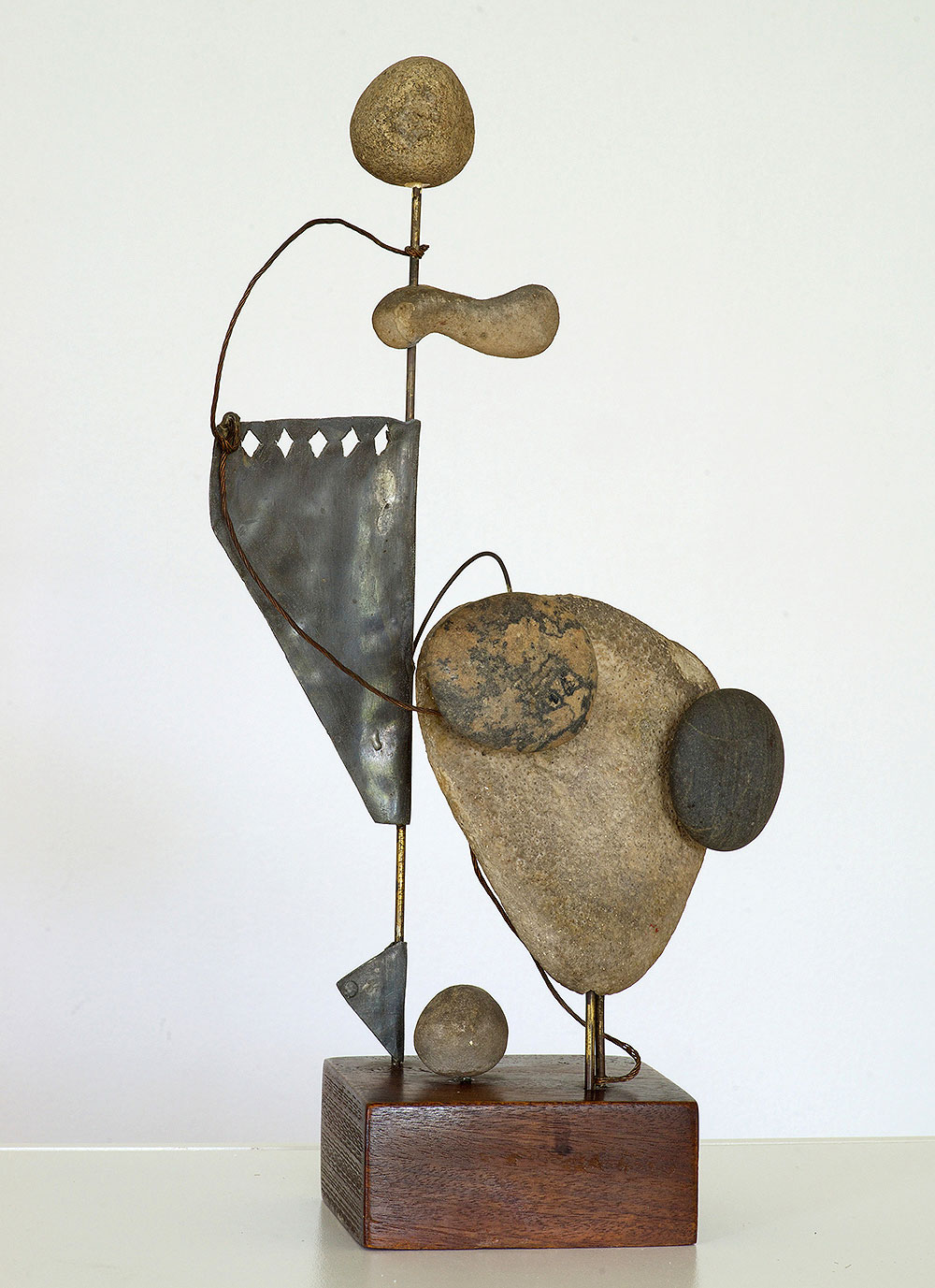
Untitled (Construction), 1933
Coral, stones, lead, copper wire, and brass rods on artist’s wood base
15 x 7 x 3 in. (38.1 x 17.8 x 7.6 cm)
Collection of Jon Shirley
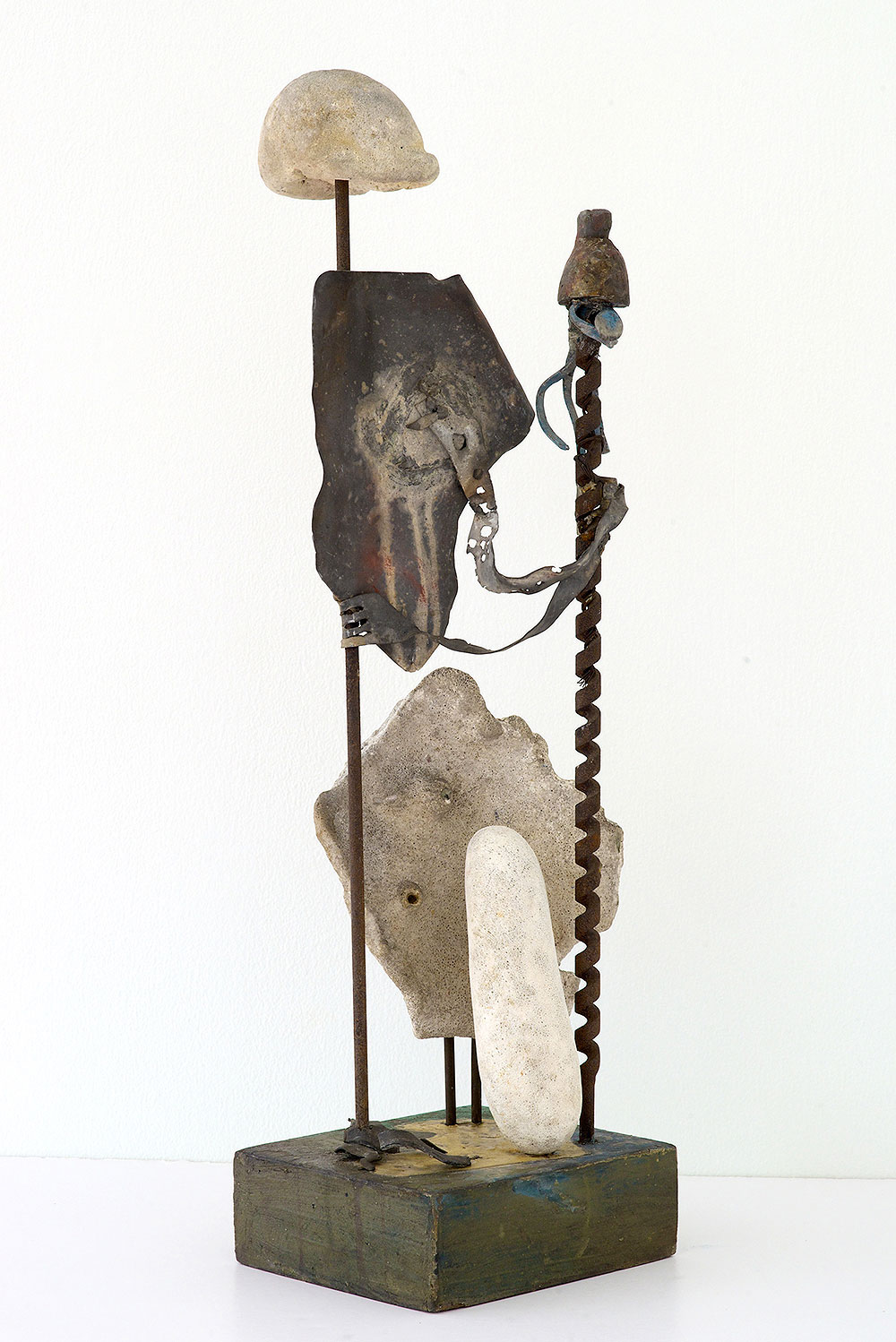
Construction (Lyndhaven), 1932
Coral, iron, lead, and painted wire on artist’s
painted wood base
25 3/4 x 7 3/4 x 5 in. (65.4 x 19.7 x 12.7 cm)
The Estate of David Smith, New York; courtesy Hauser & Wirth
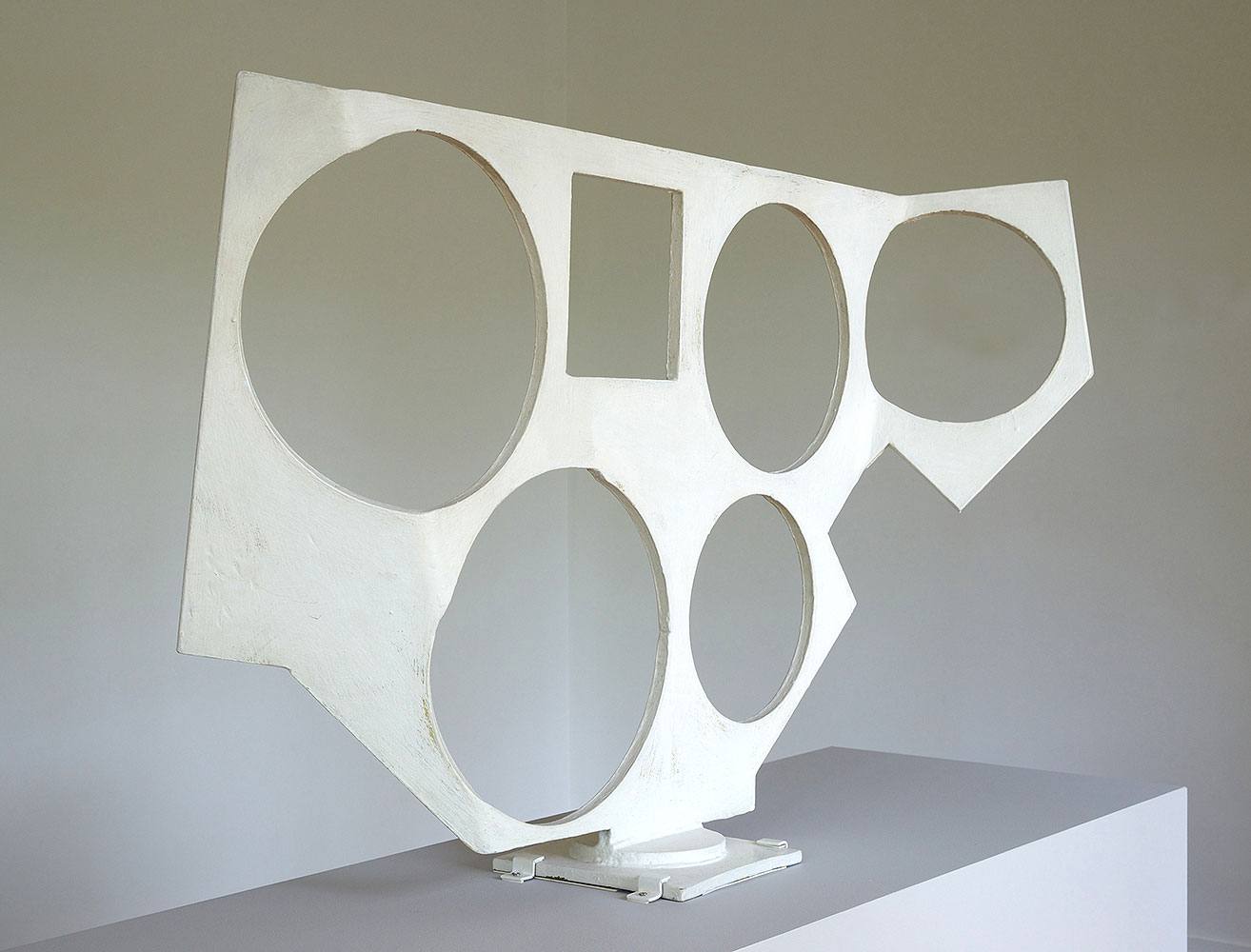
Untitled, 1955
Painted steel
29 x 45 x 34 in. (73.7 x 114.3 x 86.4 cm)
The Estate of David Smith, New York; courtesy Hauser & Wirth
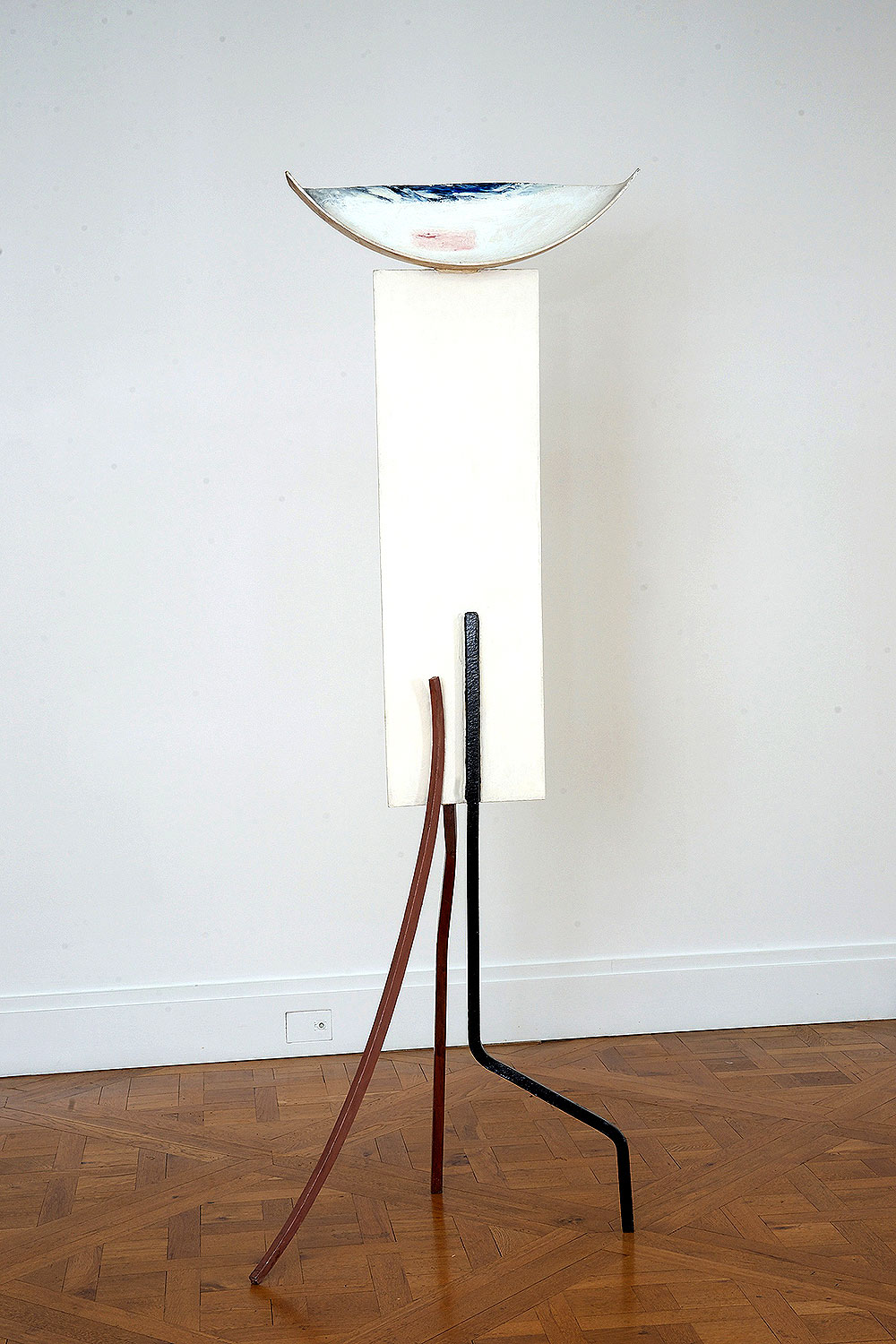
Tanktotem IX, 1960
Painted steel
90 x 33 x 24 1/8 in. (228.6 x 83.8 x 61.3 cm)
The Estate of David Smith, New York; courtesy Hauser & Wirth

Tanktotem VII, 1960
Painted steel
84 1/2 x 37 x 14 1/8 in. (214.6 x 94 x 35.9 cm)
Gift of the Ralph E. Ogden Foundation
Tanktotem VII is one of the last in Smith’s Tanktotem series (1953–60), which comprises ten sculptures, each incorporating parts of prefabricated boiler tank ends. The work reflects two aspects central to the artist’s creative interest: an admiration for the working methods traditionally linked to industrial labor, and an attraction to the verticality of the totemic form with its connections to ancient sculptural traditions as well as to early modern abstraction. Smith treated the surface of Tanktotem VII like a three-dimensional canvas, and created a painting whose forms are in dialogue with the geometry of the sculptural object.
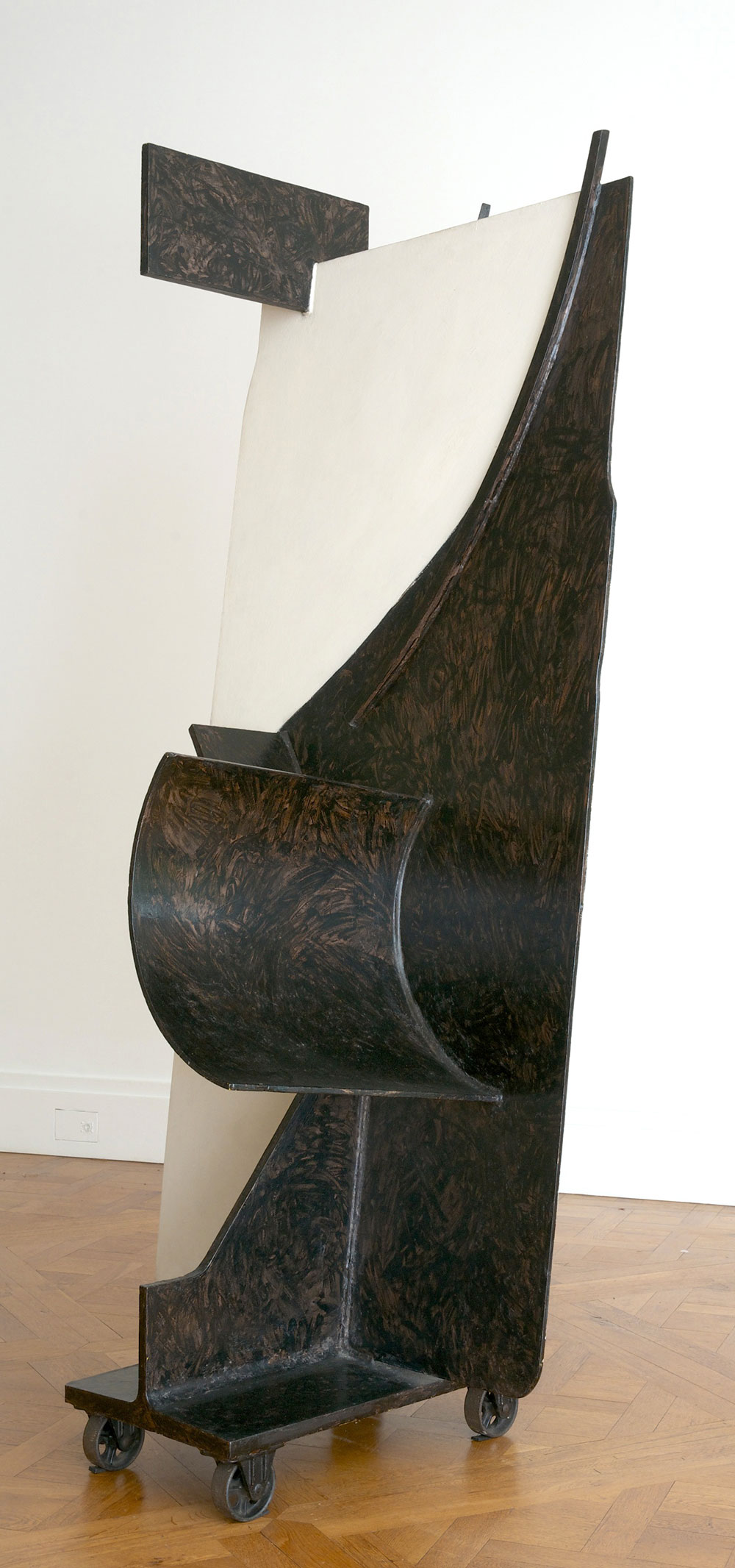
Black White Forward, 1961
Painted steel
88 1/8 x 48 x 38 in. (223.8 x 121.9 x 96.5 cm)
The Estate of David Smith, New York; courtesy Hauser & Wirth
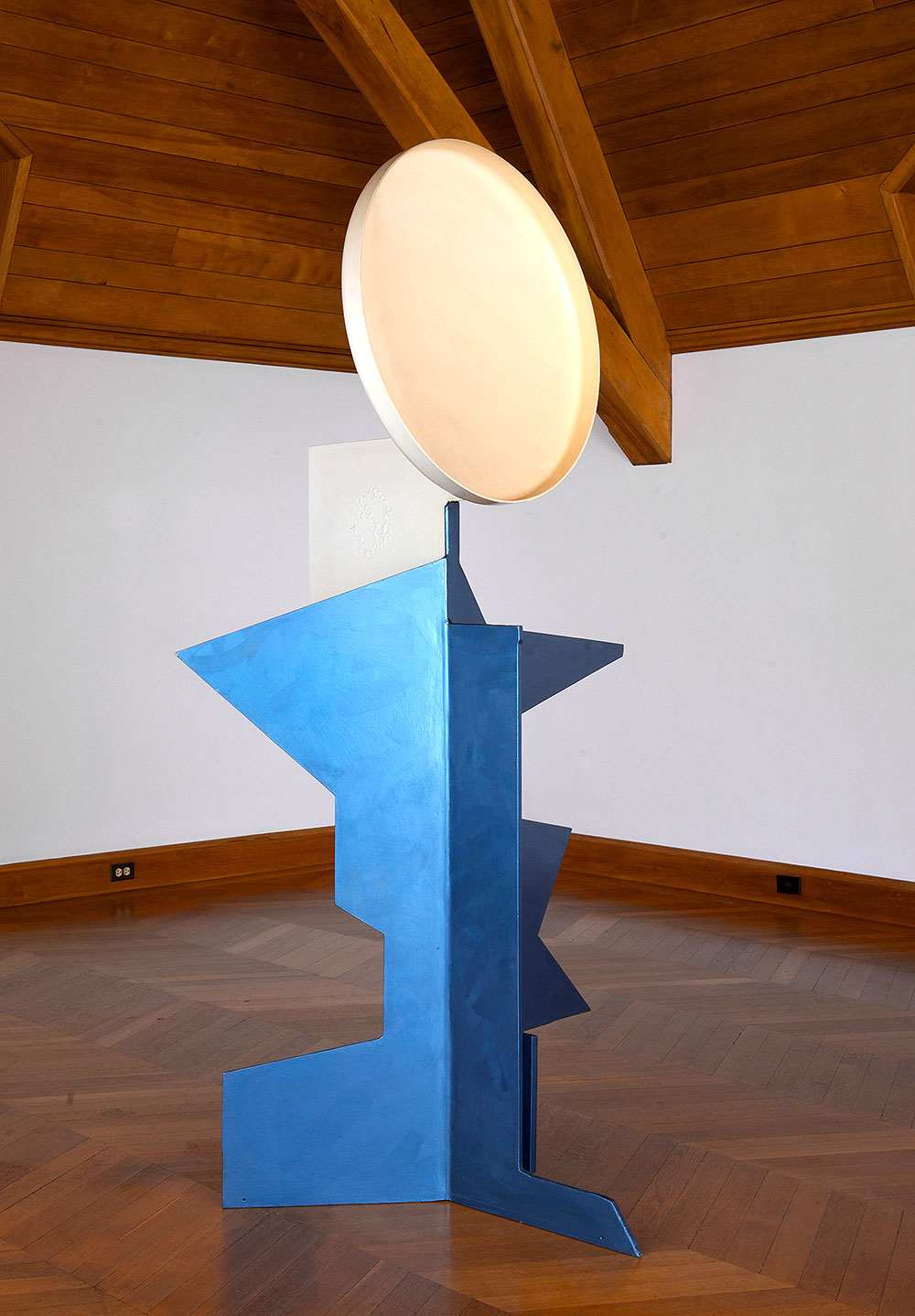
4/28/61, 1961
Painted steel
88 1/2 x 46 x 39 in. (224.8 x 116.8 x 99.1 cm)
The Lipman Family Foundation
Smith considered the painted surface of a sculpture of equal importance to form, saying, “It is obvious that there exists a logic of color relationship to sculptural form just as there exists a logic in the scale of sculpture.” In this work, named after the date of its completion, a light-hued disc appears like a face gazing upward on top of what Smith described as a “moon blue” armature. The choice of colors gives the sculpture an anthropomorphic quality as the lower portion of the sculpture, like a body, is darker than top portion, a disc-like head; this strategy Smith employed in a number of his painted-steel sculptures from the 1960s. This is the first time this work has been exhibited publicly.
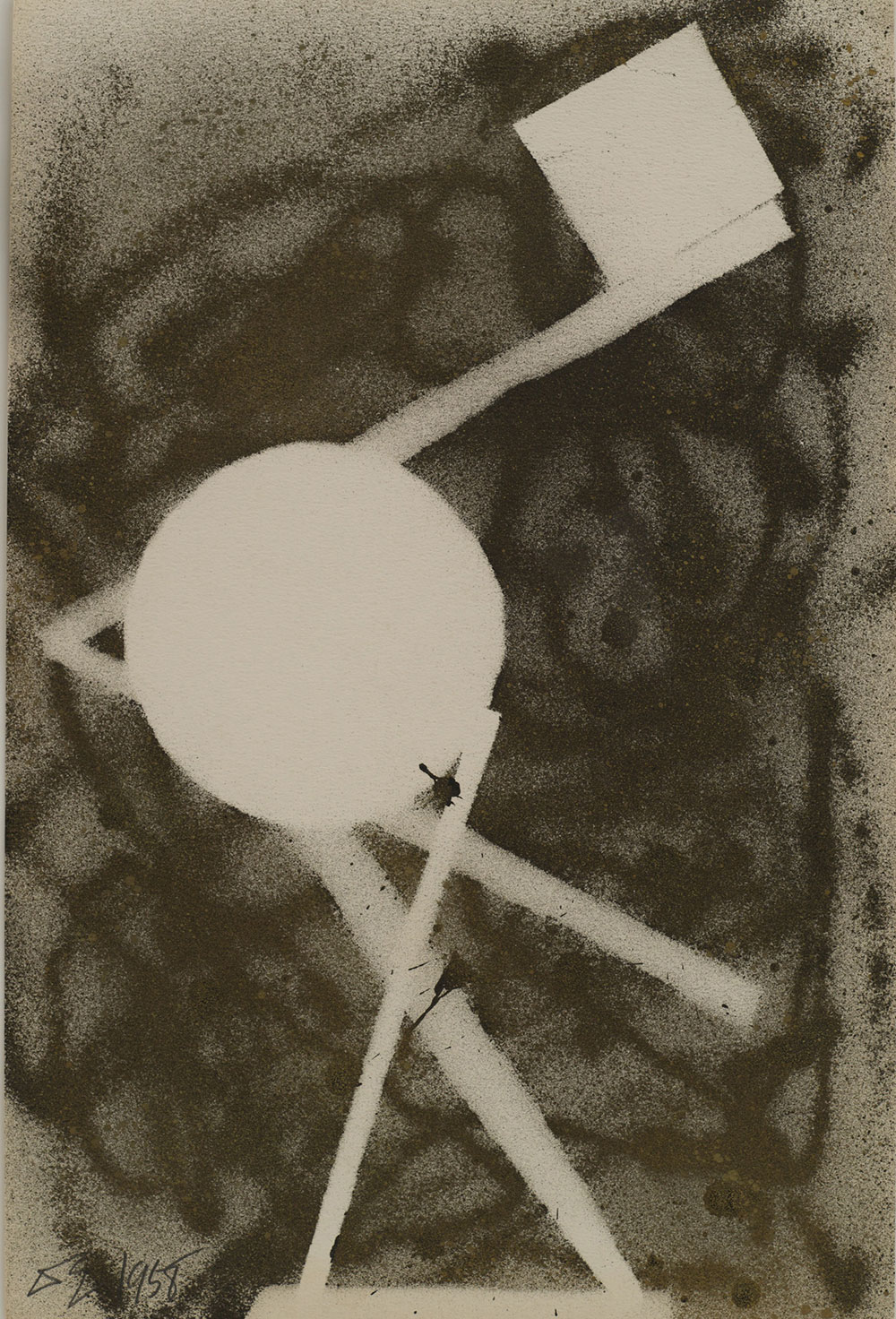
ΔΣ 1958, 1958
Spray enamel on paper
17 1/2 x 11 3/8 in. (44.5 x 28.9 cm)
The Estate of David Smith, New York; courtesy Hauser & Wirth
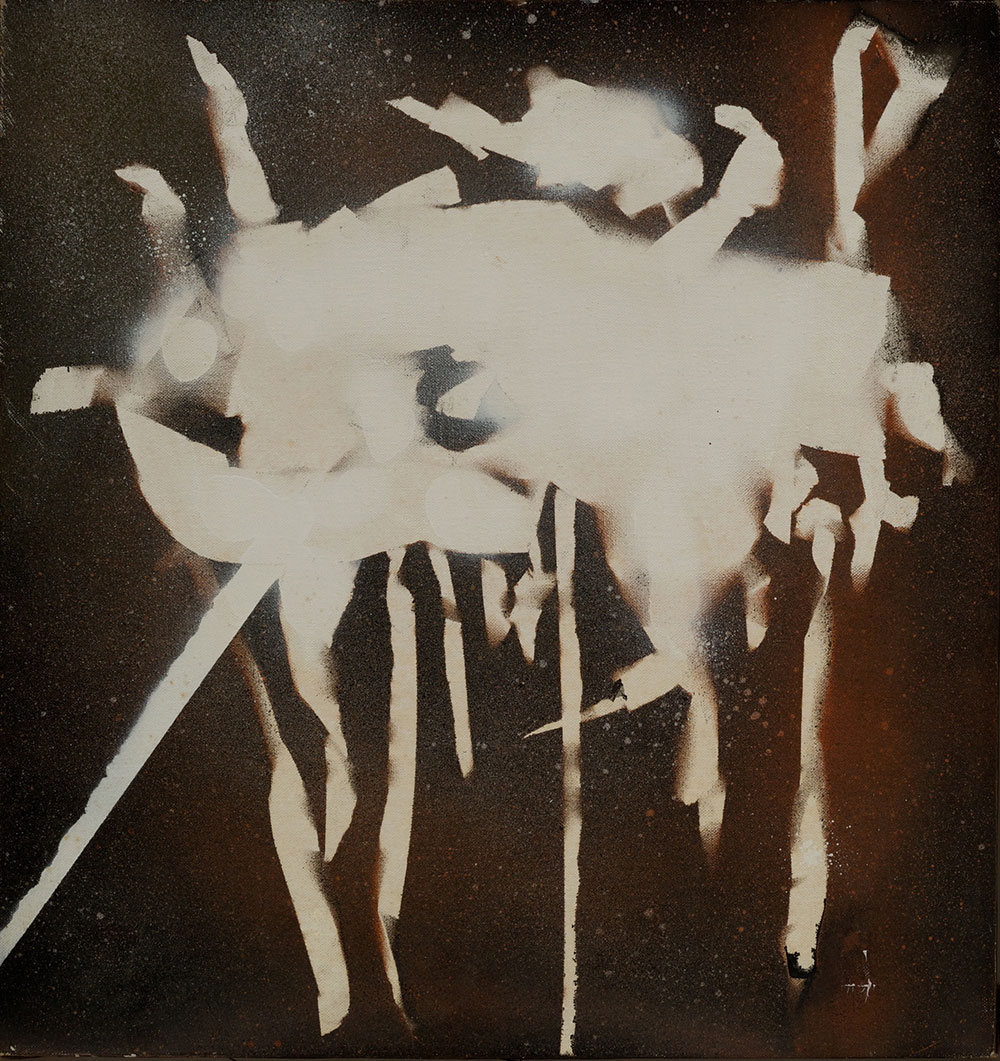
Untitled, 1958
Spray enamel on canvas
18 x 17 in. (45.7 x 43.2 cm)
The Estate of David Smith, New York; courtesy Hauser & Wirth
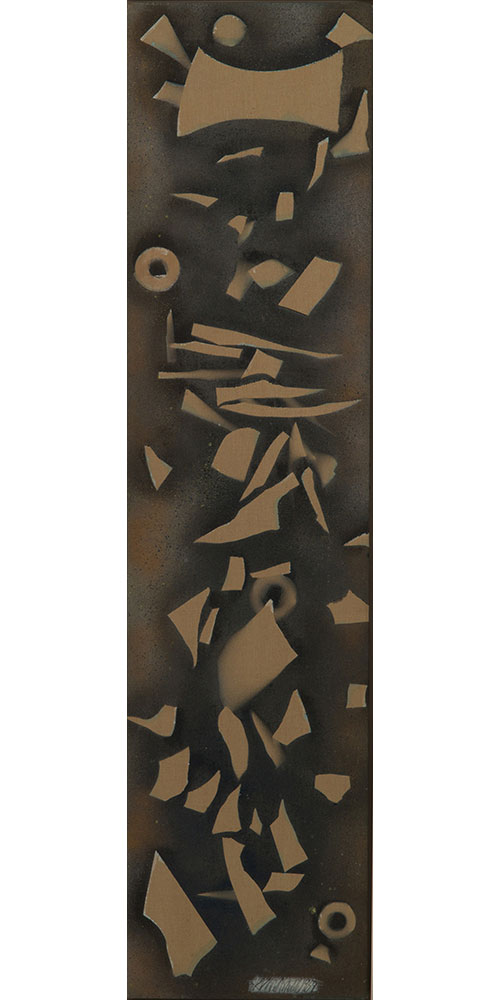
Night Window, 1959
Spray enamel on canvas
72 x 17 5/8 in. (182.9 x 44.8 cm)
The Estate of David Smith, New York; courtesy Hauser & Wirth
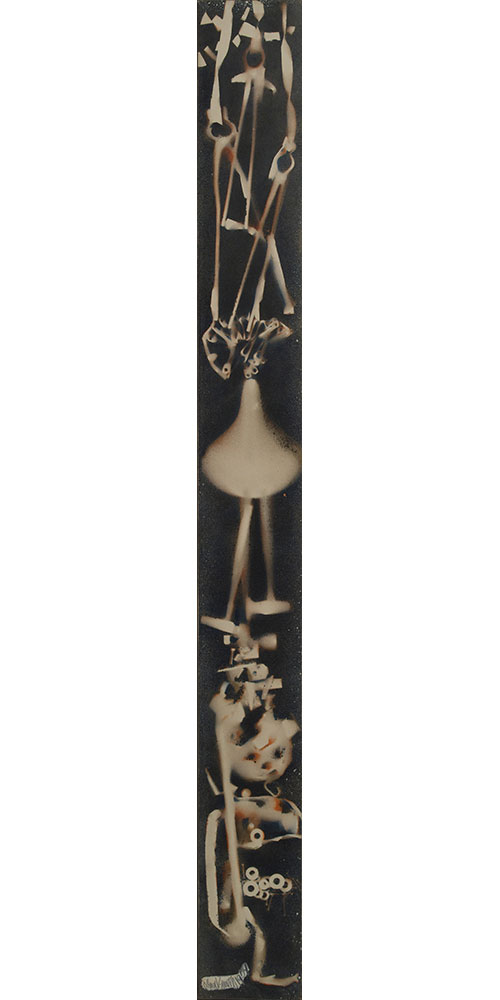
Night Window, 1959
Spray enamel on canvas
72 x 17 5/8 in. (182.9 x 44.8 cm)
The Estate of David Smith, New York; courtesy Hauser & Wirth
In order to create his “spray” paintings, which he began in 1957, Smith would place objects on an unstretched, primed canvas and spray enamel onto the surface using the same technique as for painting cars. When the objects were removed, what remained was a ghostly white absence against a hazy halo of spray paint. These works were essential to Smith’s understanding of his own sculptural practice: as the artist once commented, he was interested in “dream images, subconscious images, after-images. They’re like the series of paintings I made where the image was the hole from which the sculpture was removed. What was formed there was the after-image.” All trappings of a blacksmith’s shop—nuts, bolts, tongs, two-headed hammers, and a bellows for stoking a flame—comprise the “after-images,” or missing sculptural objects, in this spray painting.
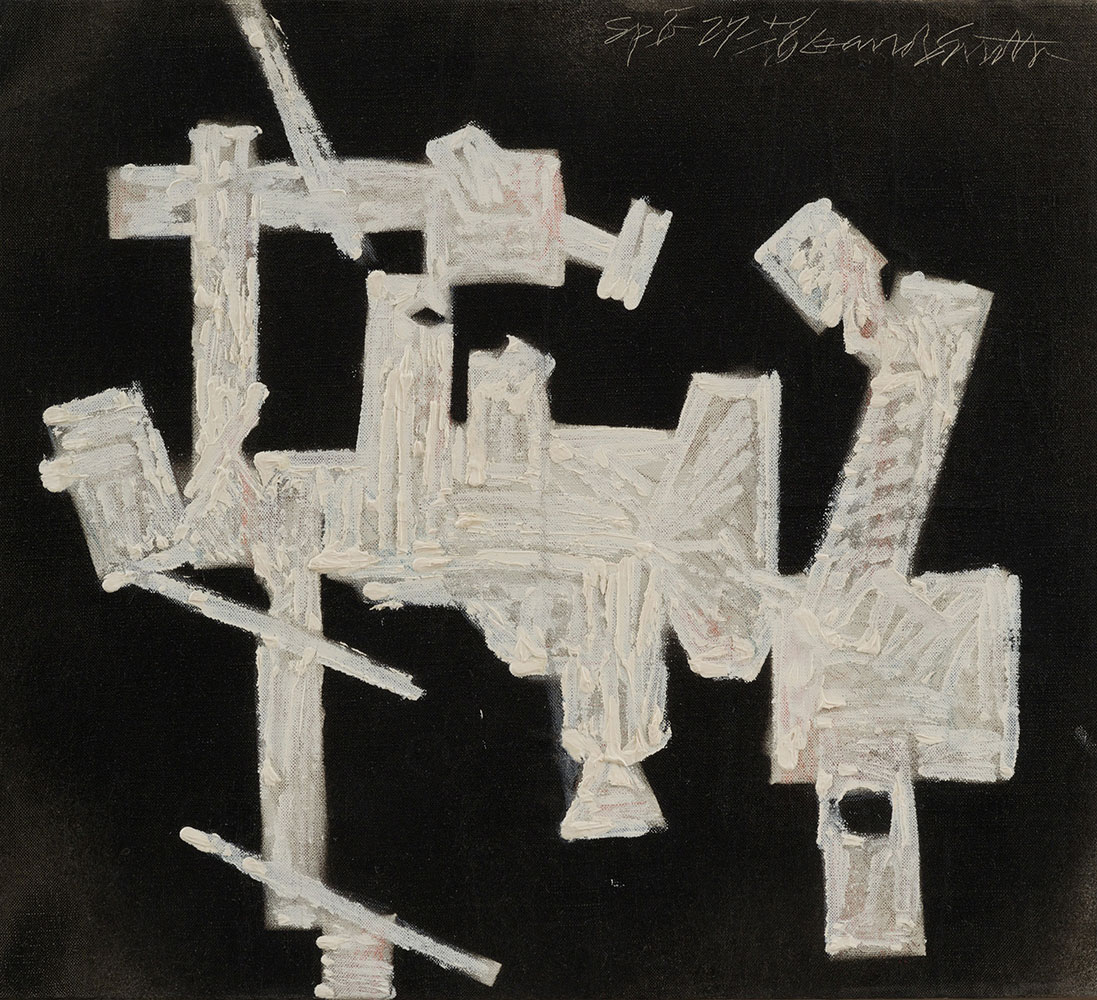
Untitled, 1958
Oil on canvas
18 1/2 x 19 in. (47 x 48.3 cm)
The Estate of David Smith, New York; courtesy Hauser & Wirth
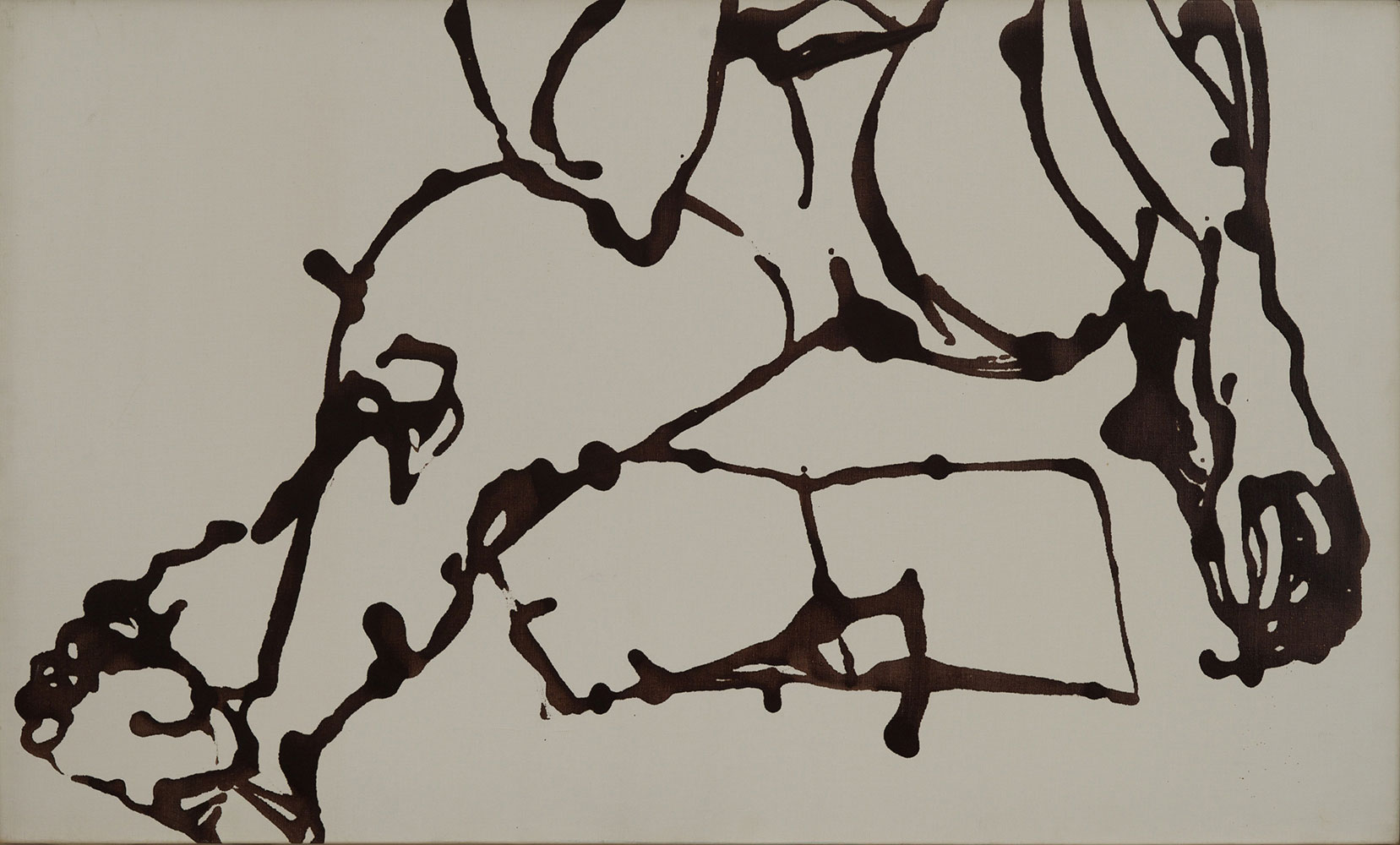
Untitled (Nude), 1964
Enamel on canvas
24 1/2 x 40 1/4 in. (62.2 x 102.2 cm)
The Estate of David Smith, New York; courtesy Hauser & Wirth
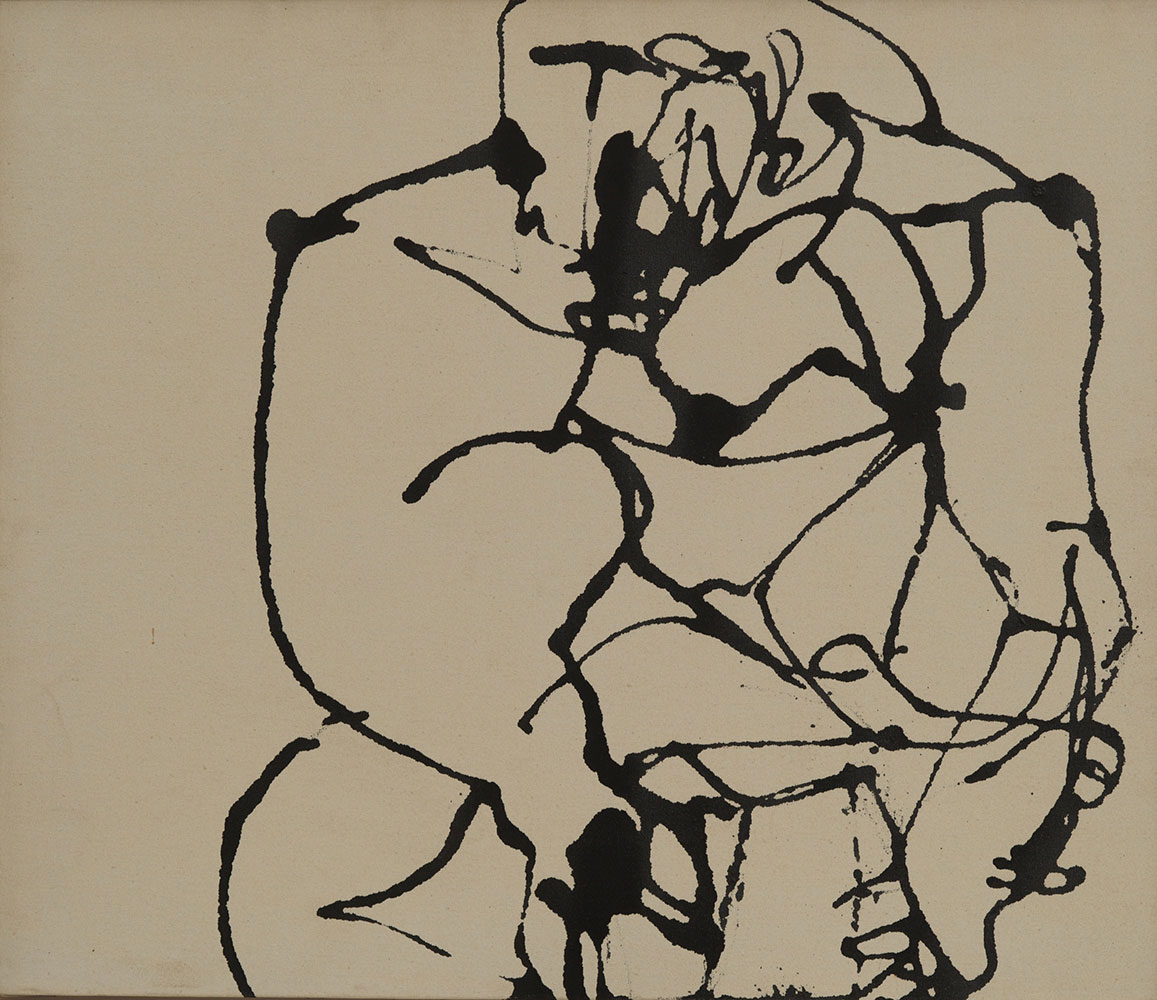
Untitled (Nude), 1964
Enamel on canvas
26 1/2 x 31 in. (67.3 x 78.7 cm)
The Estate of David Smith, New York; courtesy Hauser & Wirth
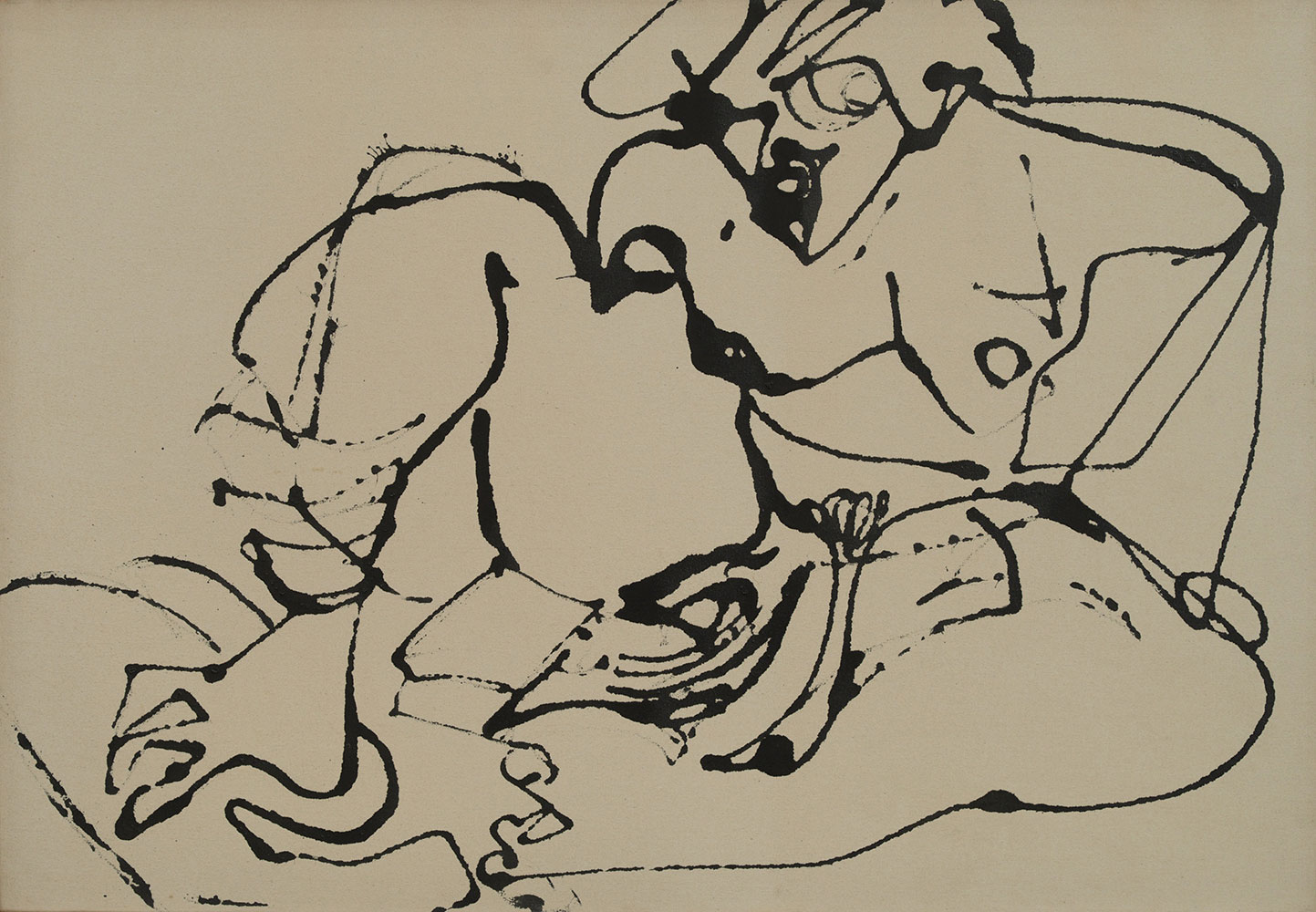
Untitled (Nude), 1964
Enamel on canvas
27 1/2 x 39 3/4 in. (69.9 x 101 cm)
The Estate of David Smith, New York; courtesy Hauser & Wirth
To achieve the distinctive “drip” characteristic of this late series of nude drawings, Smith would lay a primed, unstretched piece of canvas horizontally on a table or on the floor. Then, using an ear syringe filled with black enamel, he would squeeze the paint onto the canvas, tilting the surface to create spontaneous splashes and drips that evoke the contours and shadows of a woman’s body. Here, the swift, inky lines of the enamel suggest a crouched woman reading. Because Smith allowed the whiteness of the canvas to come to the fore of in this series of contour paintings, the black gestural drips enclose white shapes, which confuse positive and negative space.
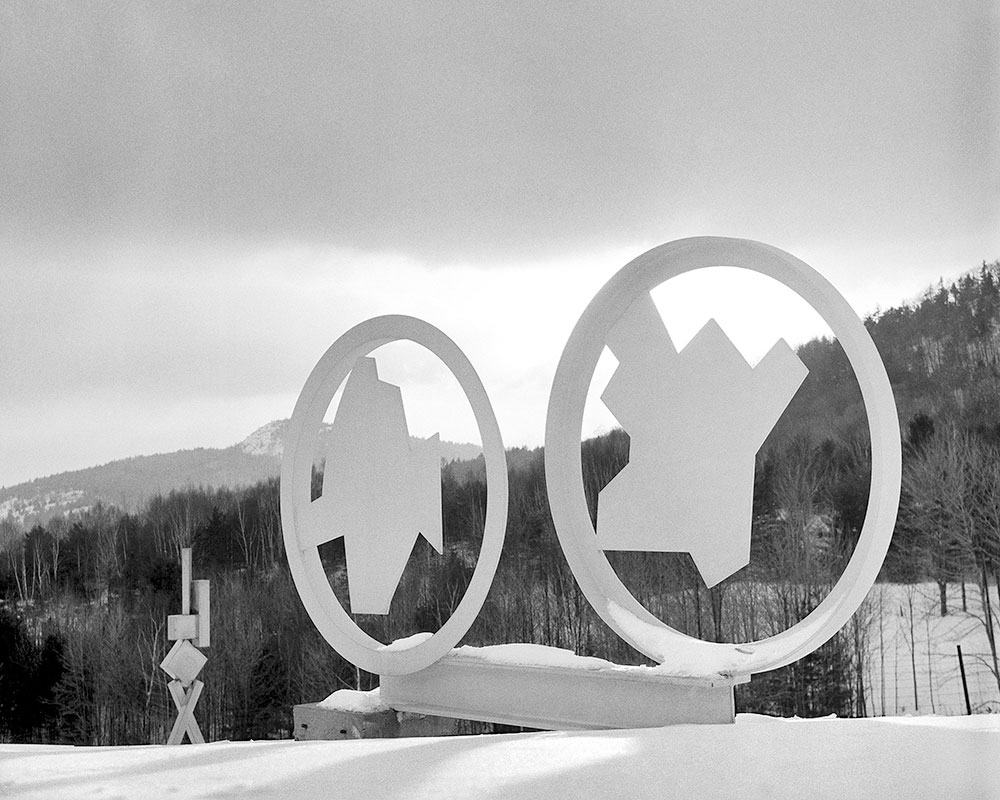
“2 Circles 2 Crows” (with “Cubi VI” in the Background), Bolton Landing, 1963
Chromogenic black-and-white print, exhibition copy
8 x 10 in. (20.3 x 25.4 cm)
The Estate of David Smith, New York
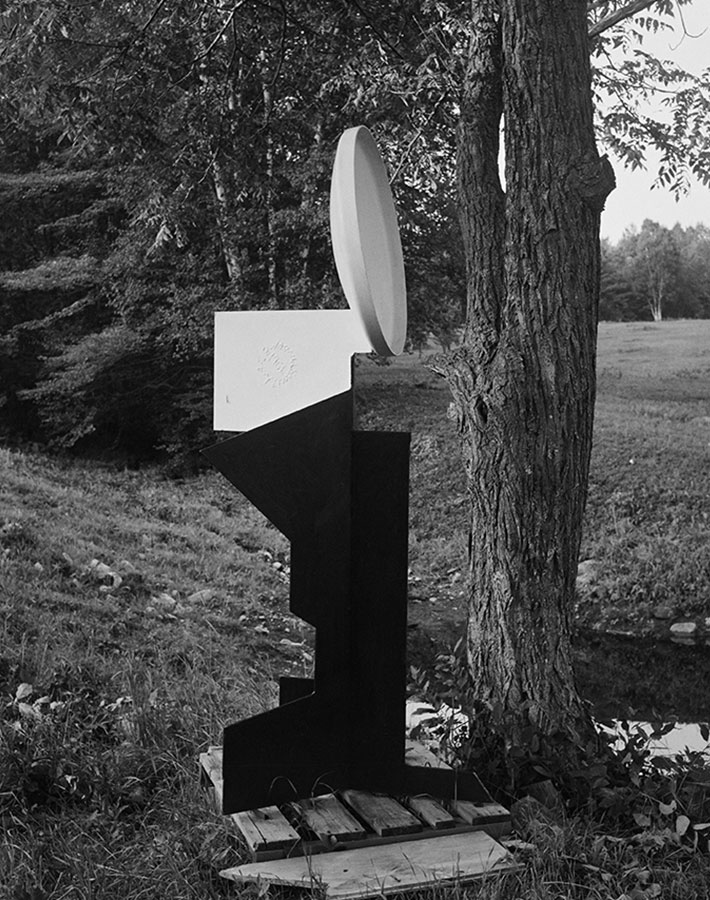
“4/28/61” at Bolton Landing, c. 1961
Chromogenic black-and-white print, exhibition copy
10 x 8 in. (25.4 x 20.3 cm)
The Estate of David Smith, New York
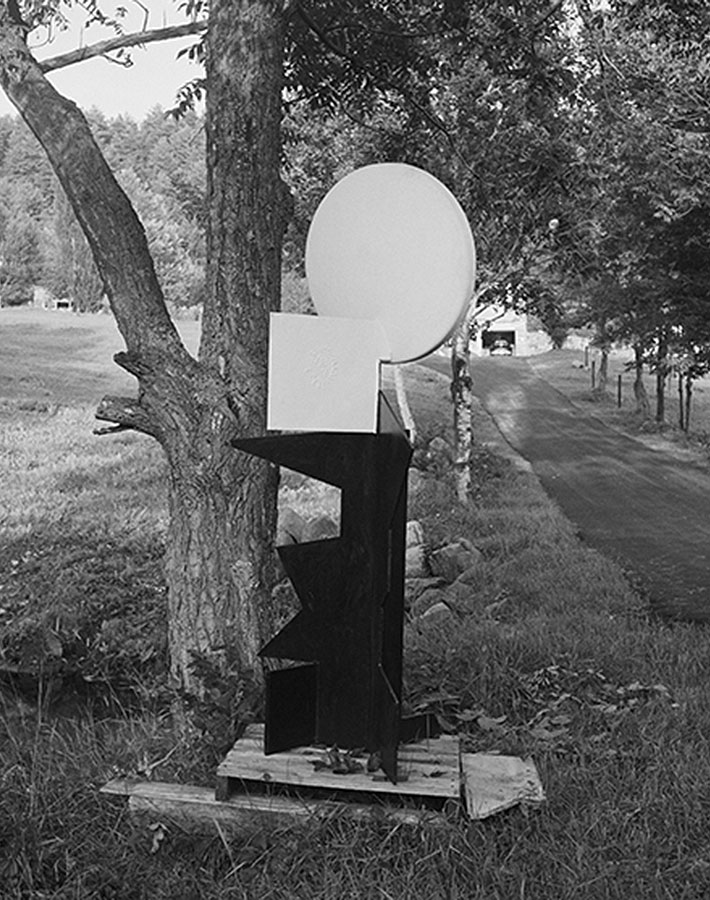
“4/28/61” at Bolton Landing, c. 1961
Chromogenic black-and-white print, exhibition copy
10 x 8 in. (25.4 x 20.3 cm)
The Estate of David Smith, New York
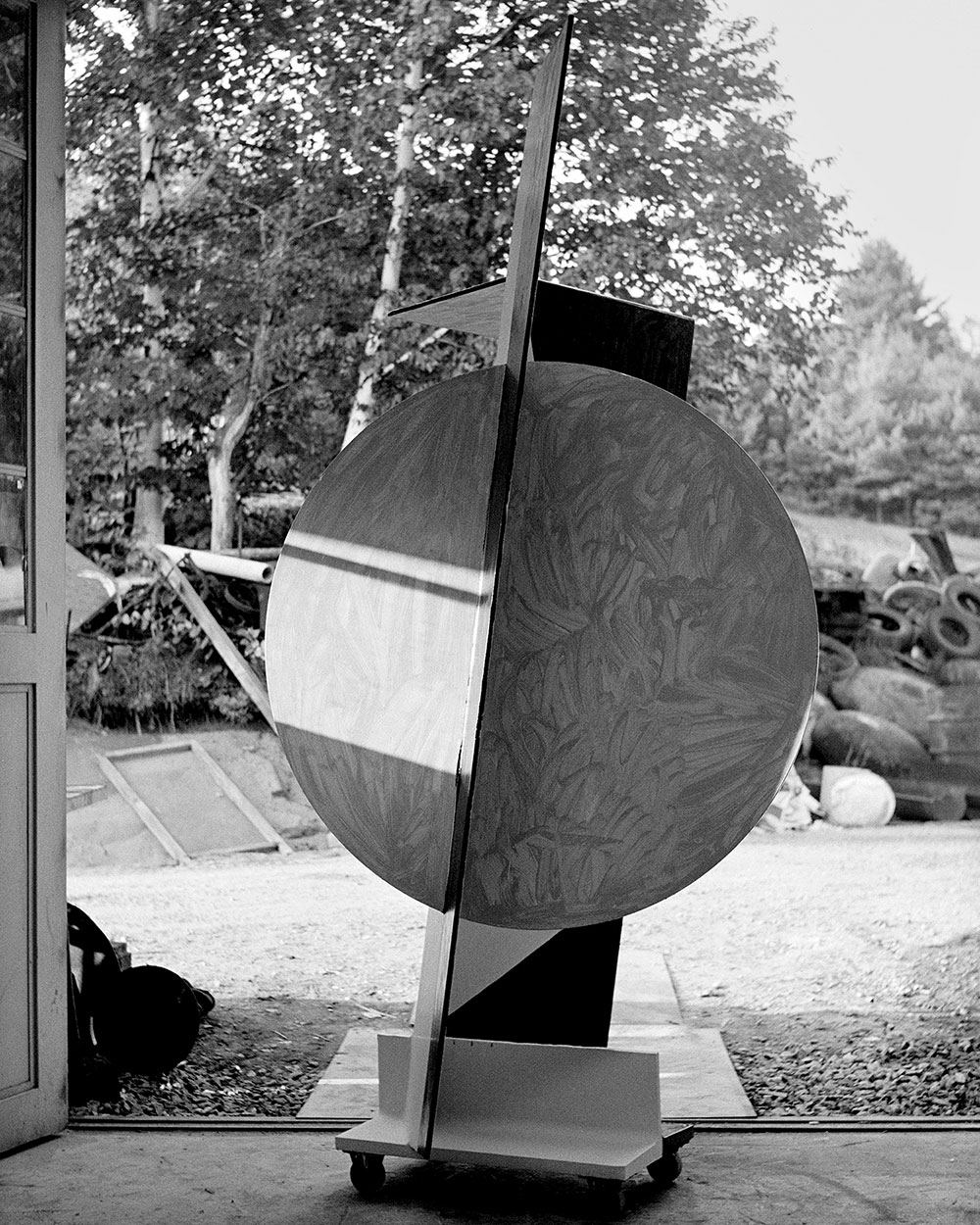
“Black White Backward” (in the Doorway of Workshop) at Bolton Landing, c. 1961
Chromogenic black-and-white print, exhibition copy
10 x 8 in. (25.4 x 20.3 cm)
The Estate of David Smith, New York
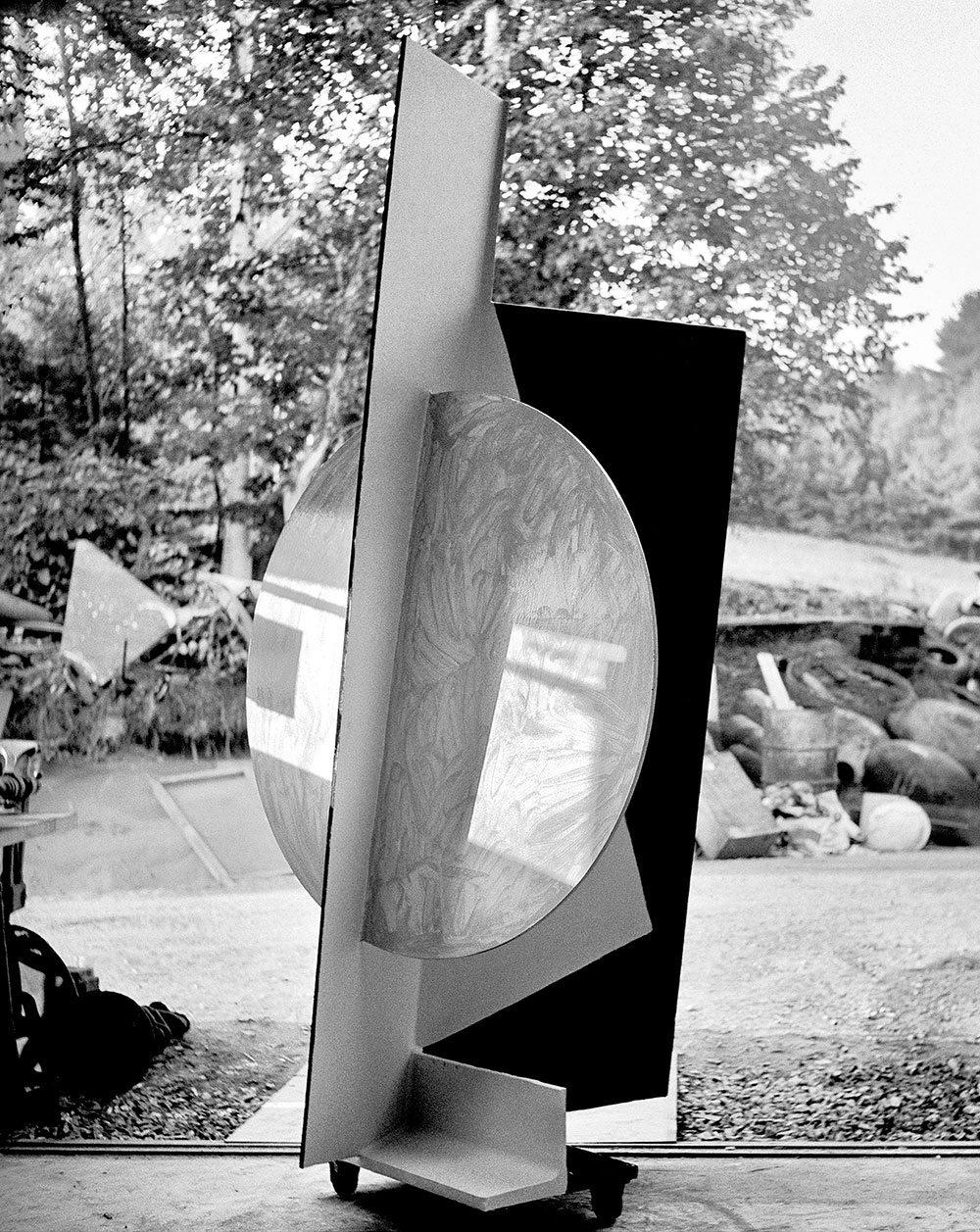
“Black White Backward” (in the Doorway of Workshop) at Bolton Landing, c. 1961
Chromogenic black-and-white print, exhibition copy
10 x 8 in. (25.4 x 20.3 cm)
The Estate of David Smith, New York
Smith captured in this photograph his sculpture, Black White Backward, in the doorway of his studio, like a frame within a frame. A single beam of light cascades across the disc shape that centers the composition, demonstrating the artist’s interest in how light interacts with the surface and form of his works. White rectangles overlap gray circles that overlap black rectangles; the overall effect flattens the sculpture into an abstraction of intersecting geometric planes. Black White Backward is a companion piece to Black White Forward (1961), included in this exhibition.

“Black White Backward” (in the Doorway of Workshop) at Bolton Landing, c. 1961
Chromogenic black-and-white print, exhibition copy
10 x 8 in. (25.4 x 20.3 cm)
The Estate of David Smith, New York
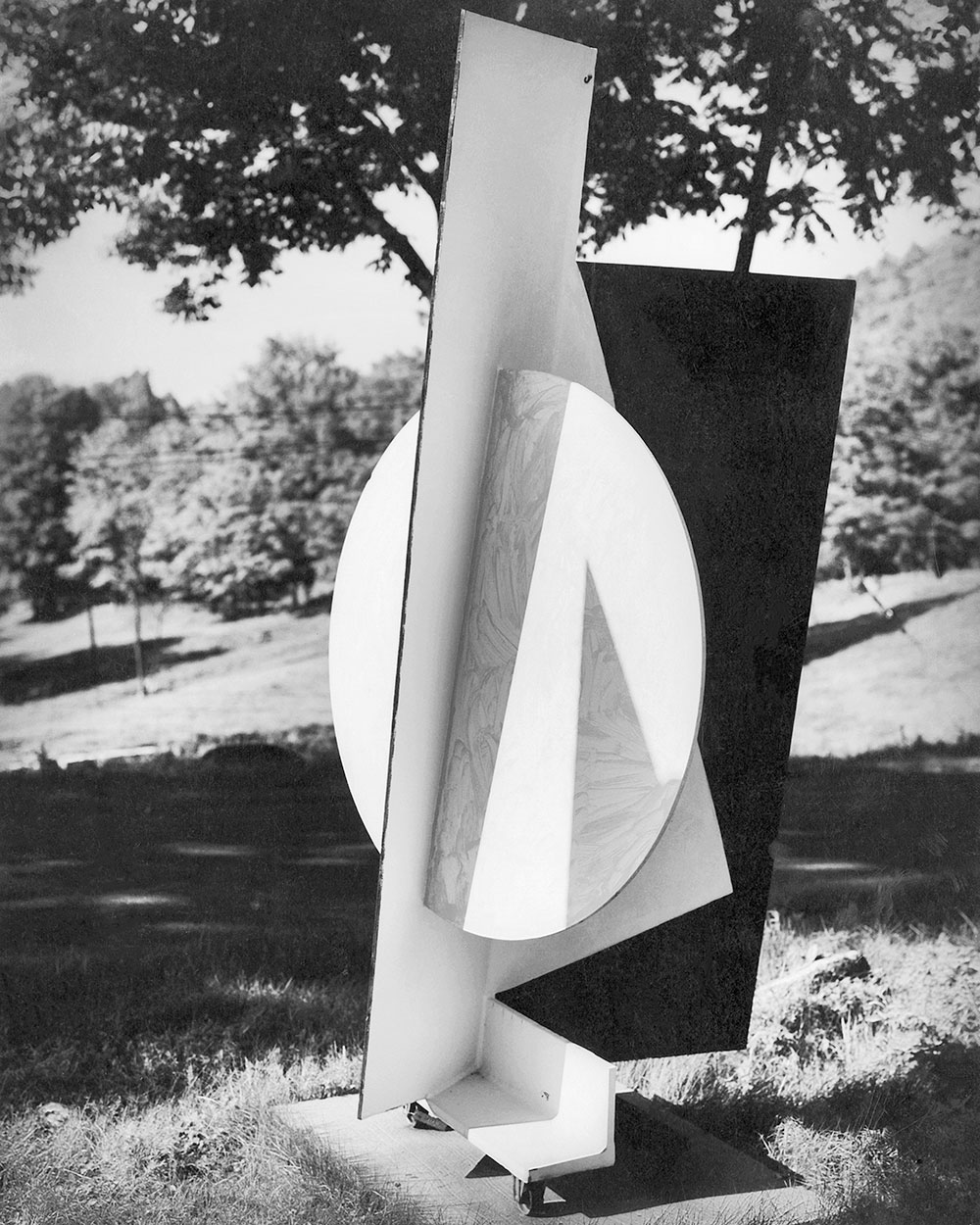
“Black White Backward” at Bolton Landing, c. 1961
Chromogenic black-and-white print, exhibition copy
10 x 8 in. (25.4 x 20.3 cm)
The Estate of David Smith, New York
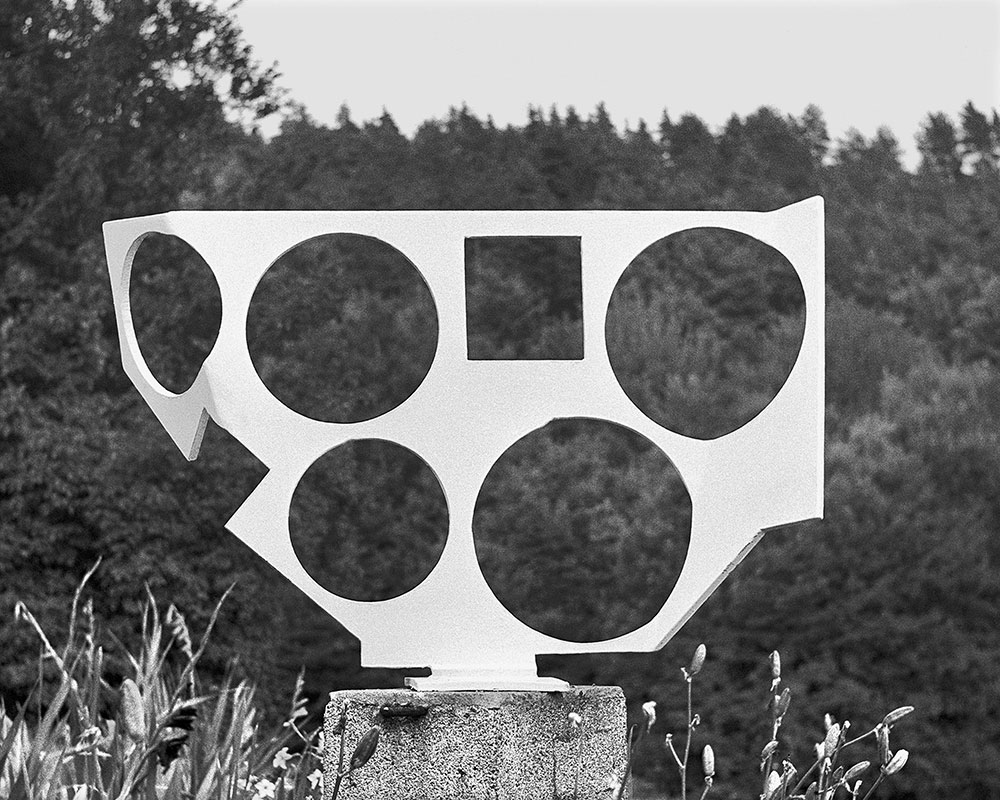
“Untitled 1955” at Bolton Landing, c. 1955
Chromogenic black-and-white print, exhibition copy
10 x 8 in. (25.4 x 20.3 cm)
The Estate of David Smith, New York
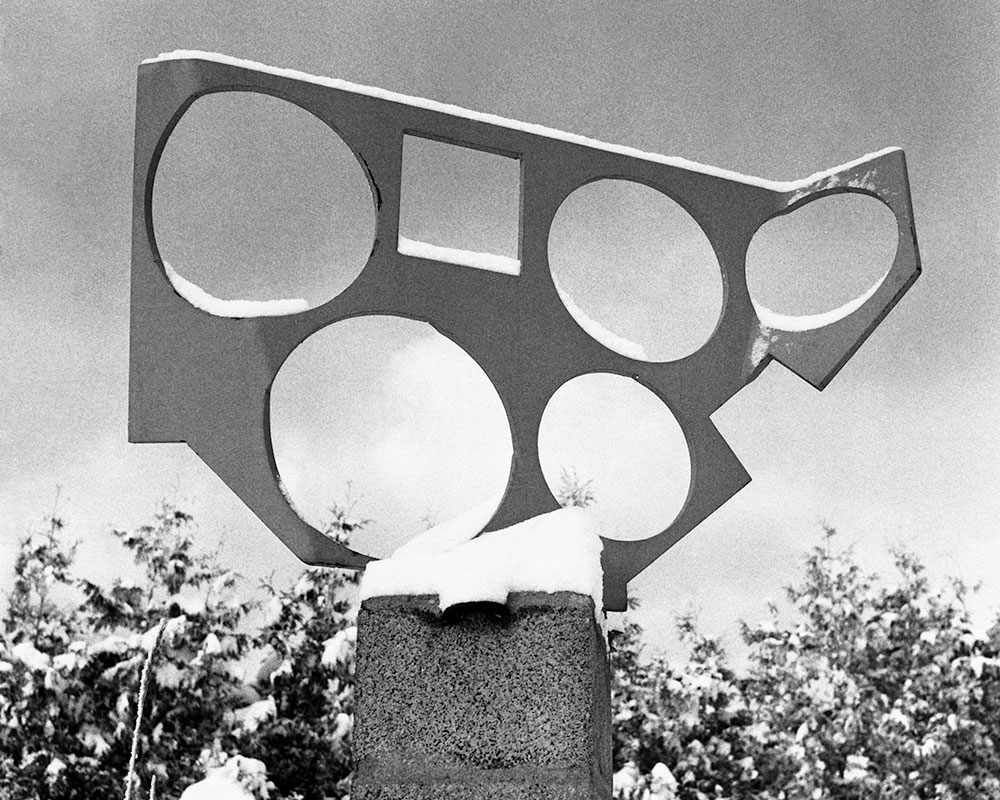
“Untitled 1955” at Bolton Landing, c. 1955
Chromogenic black-and-white print, exhibition copy
10 x 8 in. (25.4 x 20.3 cm)
The Estate of David Smith, New York
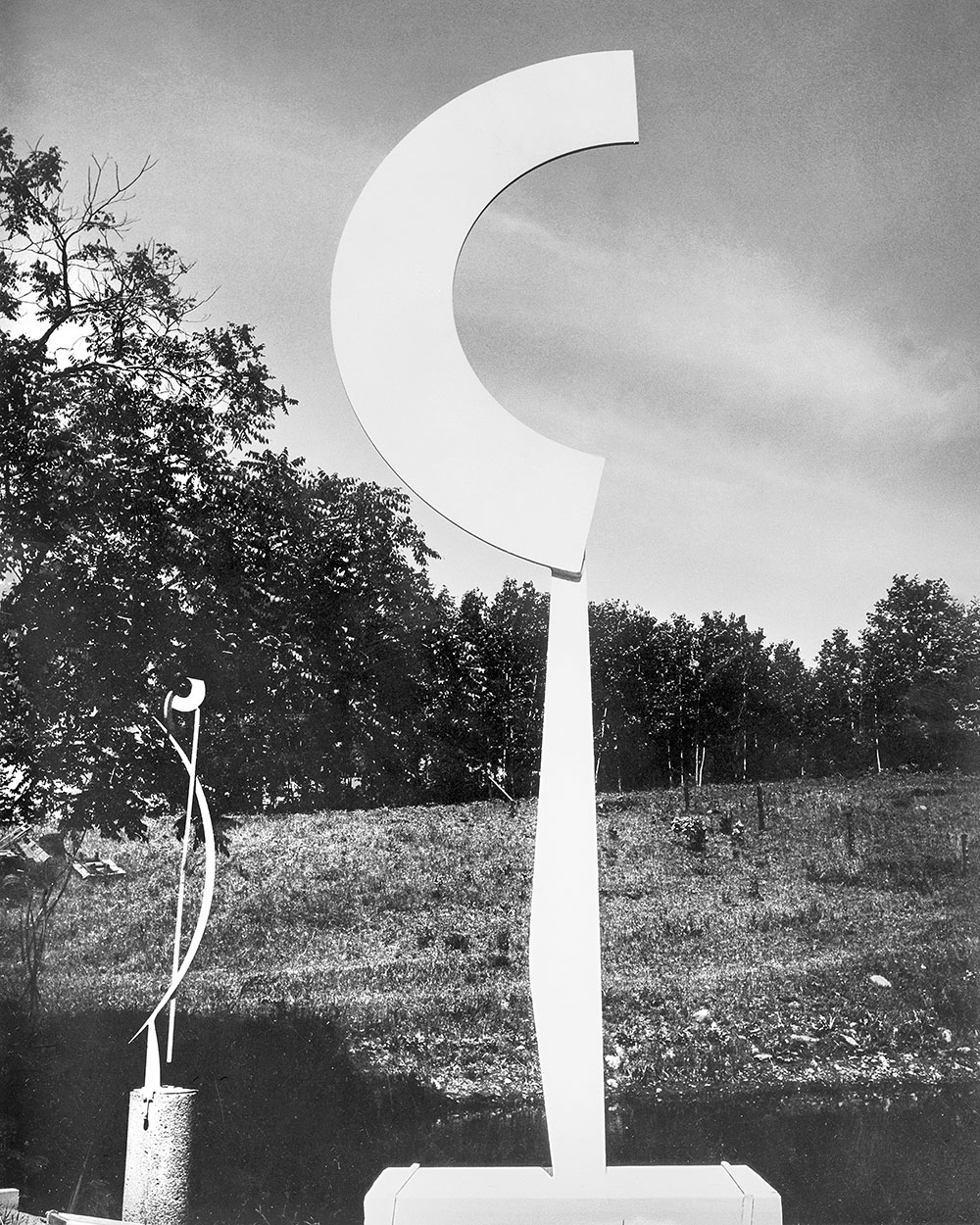
“Lunar Arc” (1961), date unknown
Chromogenic black-and-white print, exhibition copy
10 x 8 in. (25.4 x 20.3 cm)
The Estate of David Smith, New York
In this photograph, Lunar Arc—one of the eight works left painted white upon Smith’s untimely death—appears like a crescent moon against a nearly cloudless sky. Photographing his works in the landscape provided Smith the opportunity to understand his own practice more deeply. Through these images he was interested in documenting what he called the “eidetic image,” or how a sculpture’s existence as an image in the viewer’s mind supersedes its presence as a physical object. In this vein, Lunar Arc appears almost like a white cutout against the landscape instead of a three-dimensional sculpture.

“Oval Node” (with “Volton XI”, “Voltri-Bolton VIII”, “Volton XXIV”, “Volton XVIII” in Background), Bolton Landing, c. 1963
Chromogenic black-and-white print, exhibition copy
10 x 8 in. (25.4 x 20.3 cm)
The Estate of David Smith, New York
Oval Node, seen in these two photographs, is one of the eight sculptures that remained painted white upon Smith’s death, in 1965. Although it is not certain that Smith intended white to be the final color, the work remained white in the two years following its initial completion, in 1963, during which time the artist photographed it in the fields of Bolton Landing. In this image Smith uses light to play off the geometric depressions in the work’s large oval form. One photograph shows the way sunlight creates parallel hollows on the surface of the sculpture, while the shadowy appearance of the other demonstrates how the rectangular indentations can catch light and suggest depth. The way light interacts with the surface of a work was integral to the way Smith visually investigated his sculpture, as seen in many of the artist’s photographs of his works outdoors.
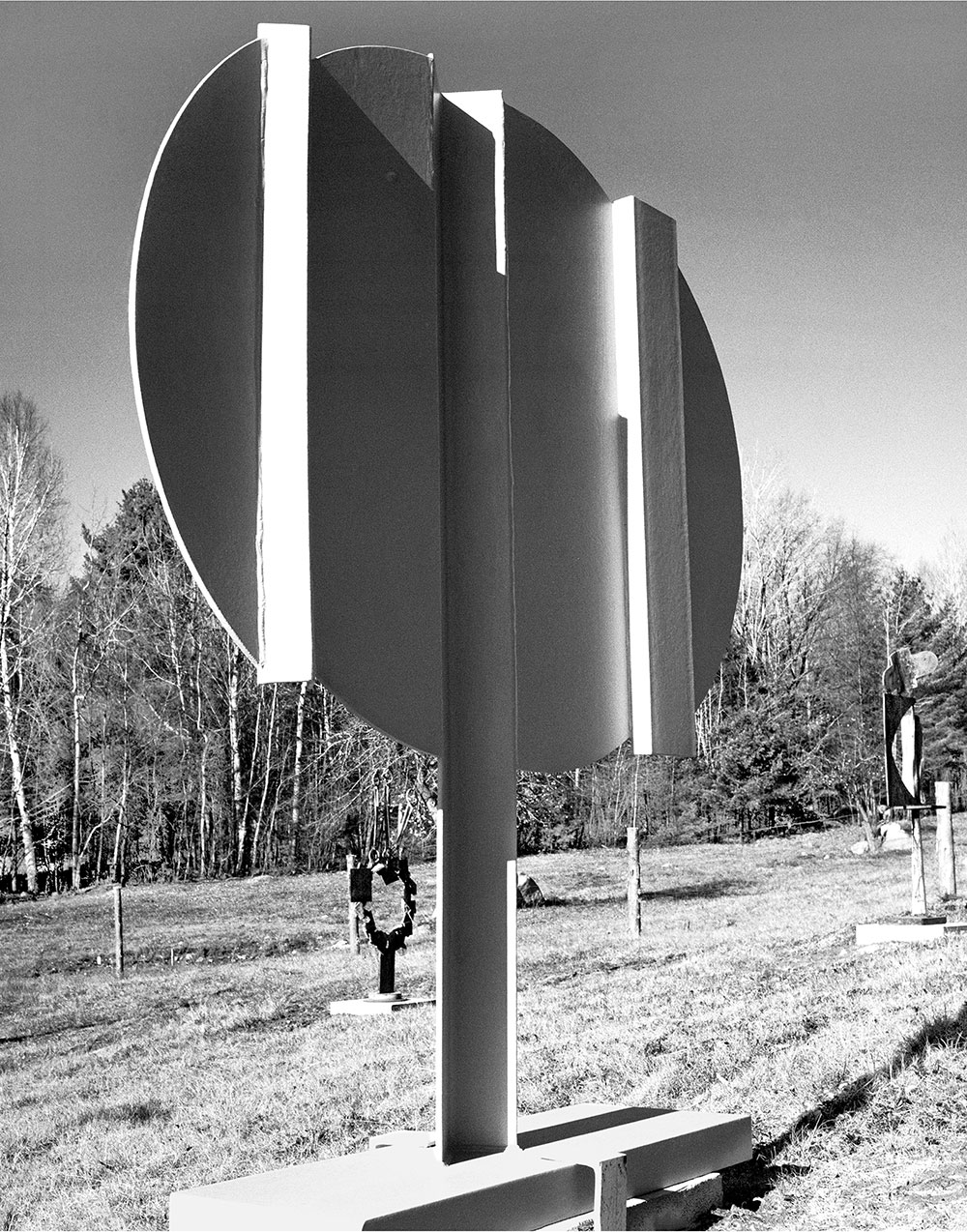
“Oval Node” (with “Voltri-Bolton V”, “Voltri-Bolton X”, and “Voltri-Bolton IV” in Background), Bolton Landing, c. 1963
Chromogenic black-and-white print, exhibition copy
10 x 8 in. (25.4 x 20.3 cm)
The Estate of David Smith, New York
Oval Node, seen in these two photographs, is one of the eight sculptures that remained painted white upon Smith’s death, in 1965. Although it is not certain that Smith intended white to be the final color, the work remained white in the two years following its initial completion, in 1963, during which time the artist photographed it in the fields of Bolton Landing. In this image Smith uses light to play off the geometric depressions in the work’s large oval form. One photograph shows the way sunlight creates parallel hollows on the surface of the sculpture, while the shadowy appearance of the other demonstrates how the rectangular indentations can catch light and suggest depth. The way light interacts with the surface of a work was integral to the way Smith visually investigated his sculpture, as seen in many of the artist’s photographs of his works outdoors.
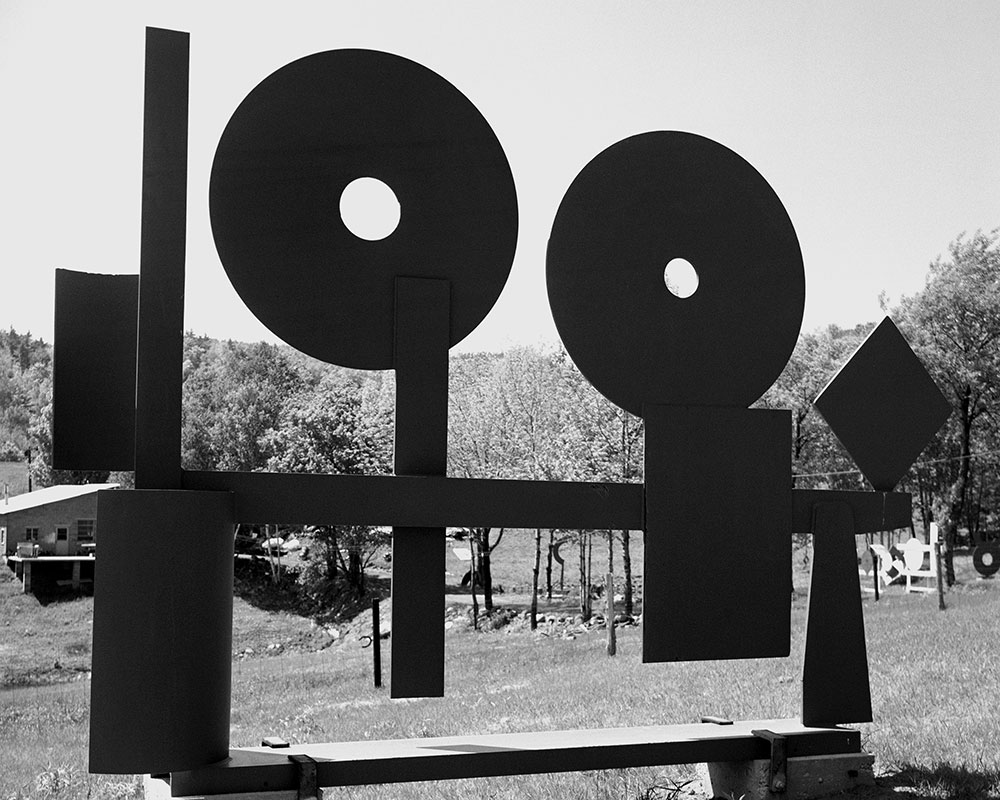
“Primo Piano I” (with “Lunar Arc”, “Primo Piano II,” “Zig IV”, “Primo Piano III” and “Circle III” in Background), Bolton Landing, c. 1962
Chromogenic black-and-white print, exhibition copy
10 x 8 in. (25.4 x 20.3 cm)
The Estate of David Smith, New York

“Primo Piano II” (with “Circle I”, and “Primo Piano III” in Background), Bolton Landing, c. 1962
Chromogenic black-and-white print, exhibition copy
10 x 8 in. (25.4 x 20.3 cm)
The Estate of David Smith, New York
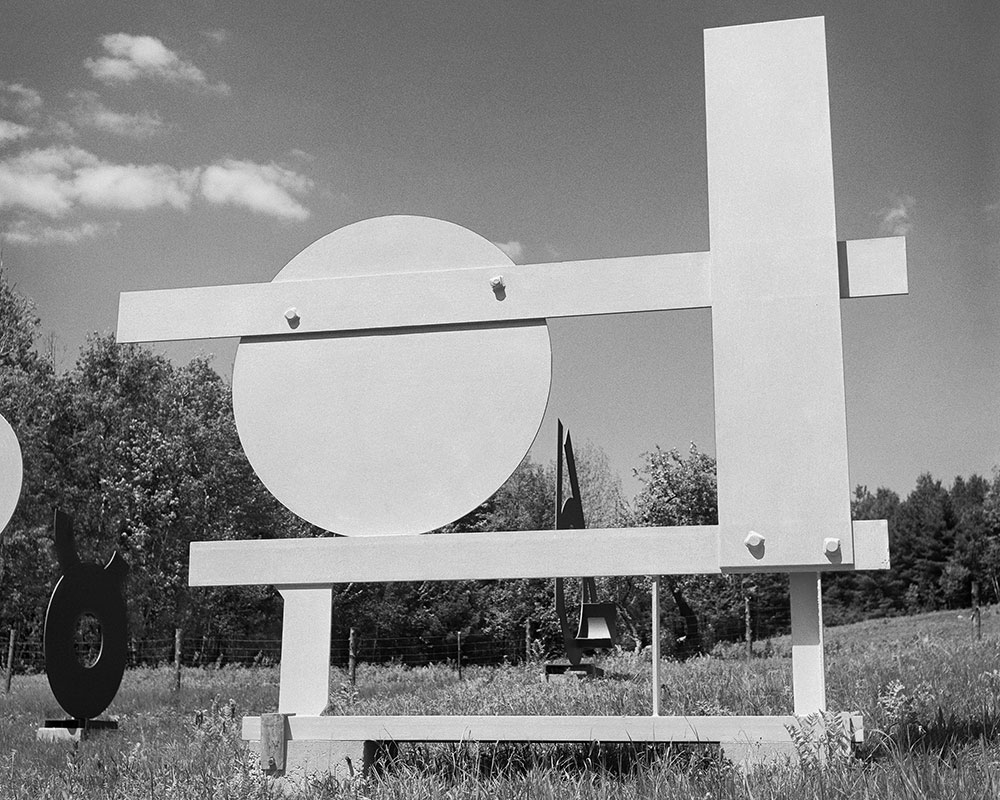
“Primo Piano III” (with “Primo Piano II”, “Circle III”, and “Circle II” in Background), Bolton Landing, 1963
Chromogenic black-and-white print, exhibition copy
10 x 8 in. (25.4 x 20.3 cm)
The Estate of David Smith, New York
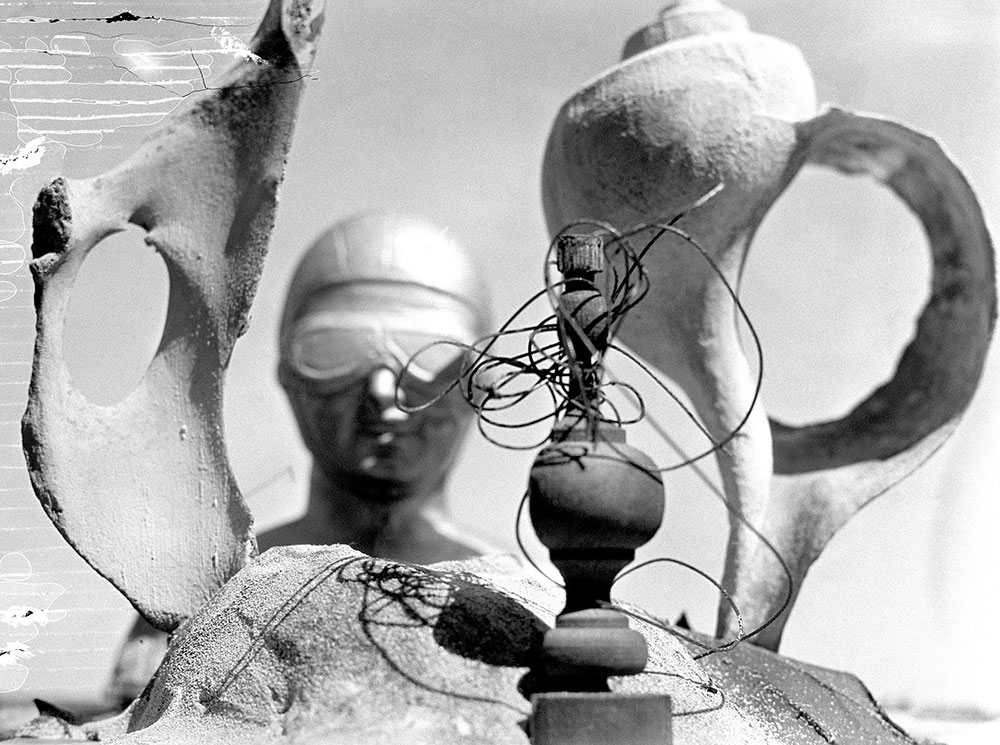
Untitled (Tableau), c. 1931–33
Chromogenic black-and-white print, exhibition copy
10 x 8 in. (25.4 x 20.3 cm)
The Estate of David Smith, New York
This Untitled (Tableau) is one of many experimental photographs created during Smith’s 1931-32 sojourn in the Virgin Islands, and demonstrates the artist’s early engagement with Surrealism, which reached its heyday in Europe by the late 1920s. The organic shape of the white coral in the foreground contrasts with the classical kneeling nude in the background, a juxtaposition that speaks to currents in Surrealist thought at the time, such as an interest in the clash between antiquity and modernity. Further in dialogue with Surrealism, the tension between figuration and abstraction within the same visual space is at the forefront of this photo. Smith emphasized the contours of the objects in the composition by scraping small lines onto the negative before generating the print; these hand-drawn details appear as faint white outlines of the nude’s thigh and the blurry coral in the background. Smith continued to understand these early coral experimentations within the context of the European avant-garde, and in 1939 he sent a number of his early photographs to Hungarian painter and photographer László Moholy-Nagy, who was then teaching at the Institute of Design in Chicago. Though Moholy-Nagy invited Smith to teach alongside him in 1944, Smith declined the invitation as his practice in photography has shifted by that point. The artist had become fully invested in sculpture by the 1940s, using the camera instead as a means to document his work situated in the fields of Bolton Landing.
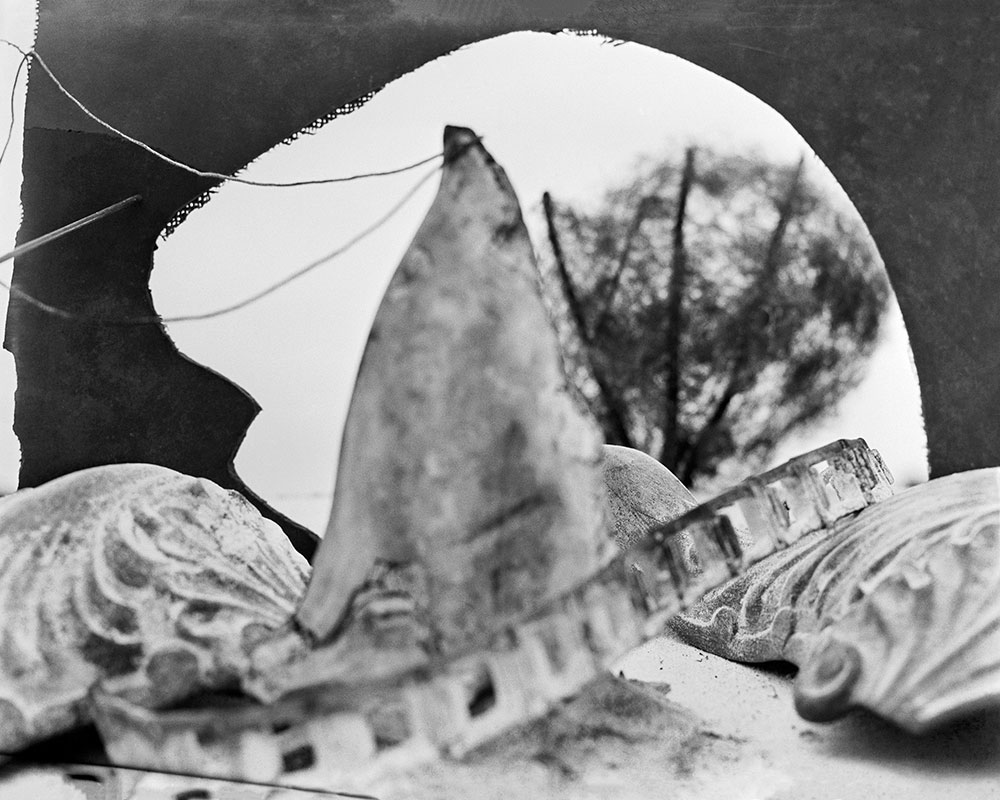
Untitled (Virgin Islands Tableau), c. 1931–32
Chromogenic black-and-white print, exhibition copy
10 x 8 in. (25.4 x 20.3 cm)
The Estate of David Smith, New York
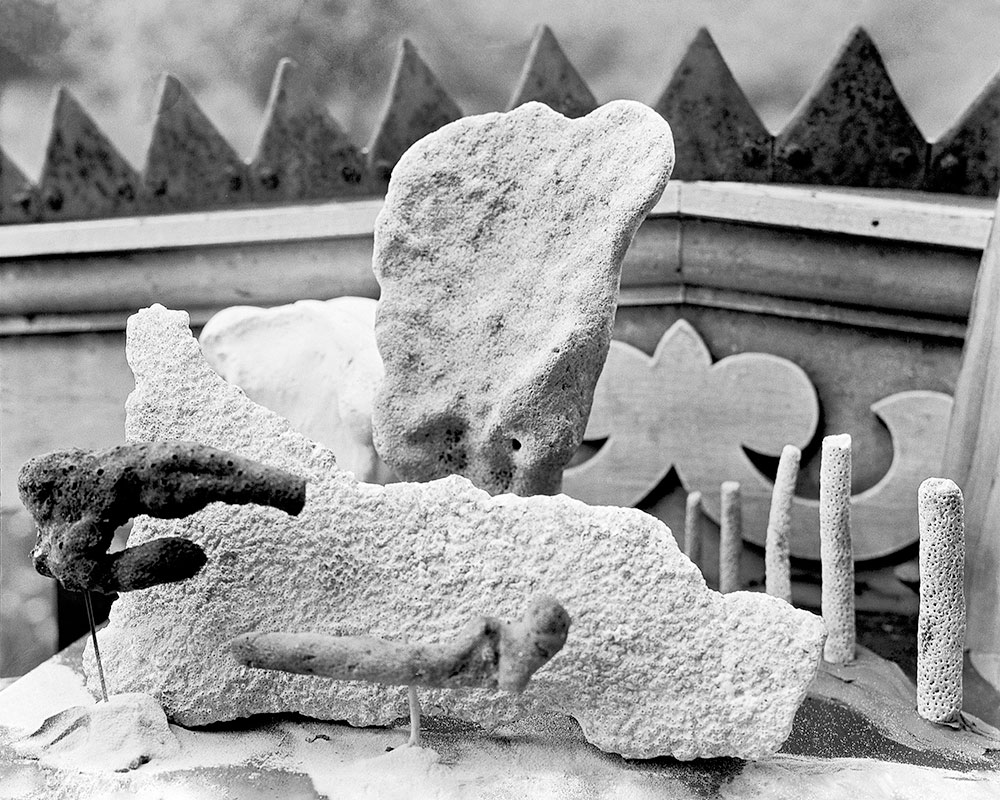
Coral Construction, c. 1931–32
Chromogenic black-and-white print, exhibition copy
10 x 8 in. (25.4 x 20.3 cm)
The Estate of David Smith, New York

Untitled (Tableau), c. 1932–33
Chromogenic black-and-white print, exhibition copy
10 x 8 in. (25.4 x 20.3 cm)
The Estate of David Smith, New York

Untitled (Virgin Islands Tableau), c. 1931–32
Chromogenic black-and-white print, exhibition copy
10 x 8 in. (25.4 x 20.3 cm)
The Estate of David Smith, New York

Shell Construction, 1931
Chromogenic black-and-white print, exhibition copy
10 x 8 in. (25.4 x 20.3 cm)
The Estate of David Smith, New York
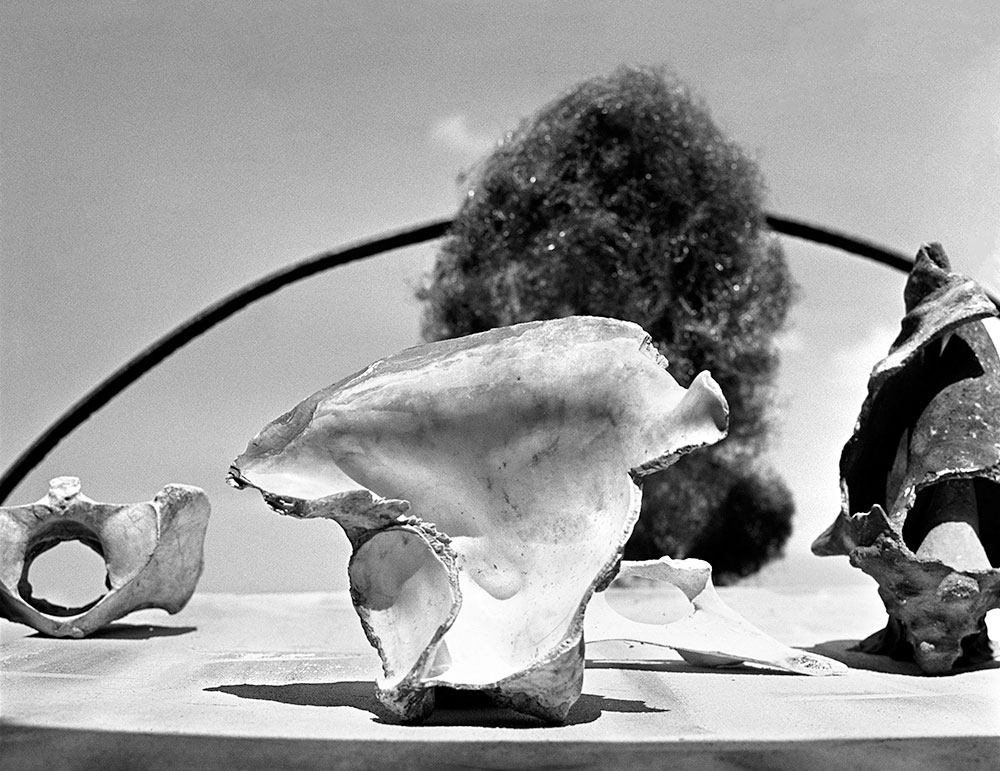
Construction, 1931
Chromogenic black-and-white print, exhibition copy
10 x 8 in. (25.4 x 20.3 cm)
The Estate of David Smith, New York

Untitled, c. 1932–35
Chromogenic black-and-white print, exhibition copy
10 x 8 in. (25.4 x 20.3 cm)
The Estate of David Smith, New York
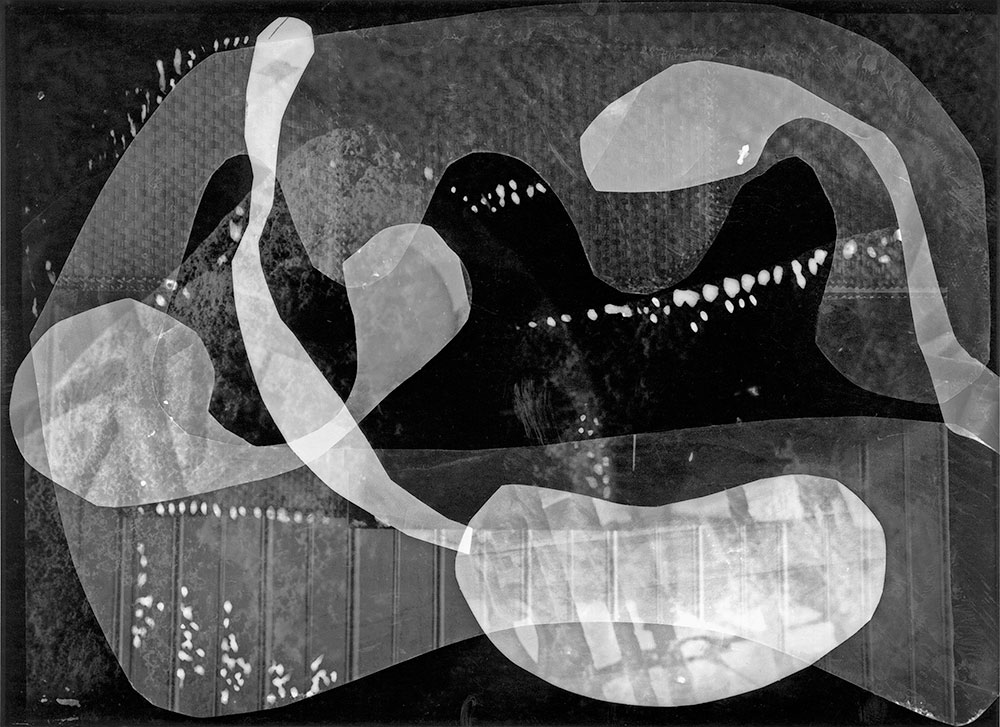
Untitled, c. 1932–35
Chromogenic black-and-white print of photocollage
5 x 8 in. (12.7 x 20.3 cm)
The Estate of David Smith, New York
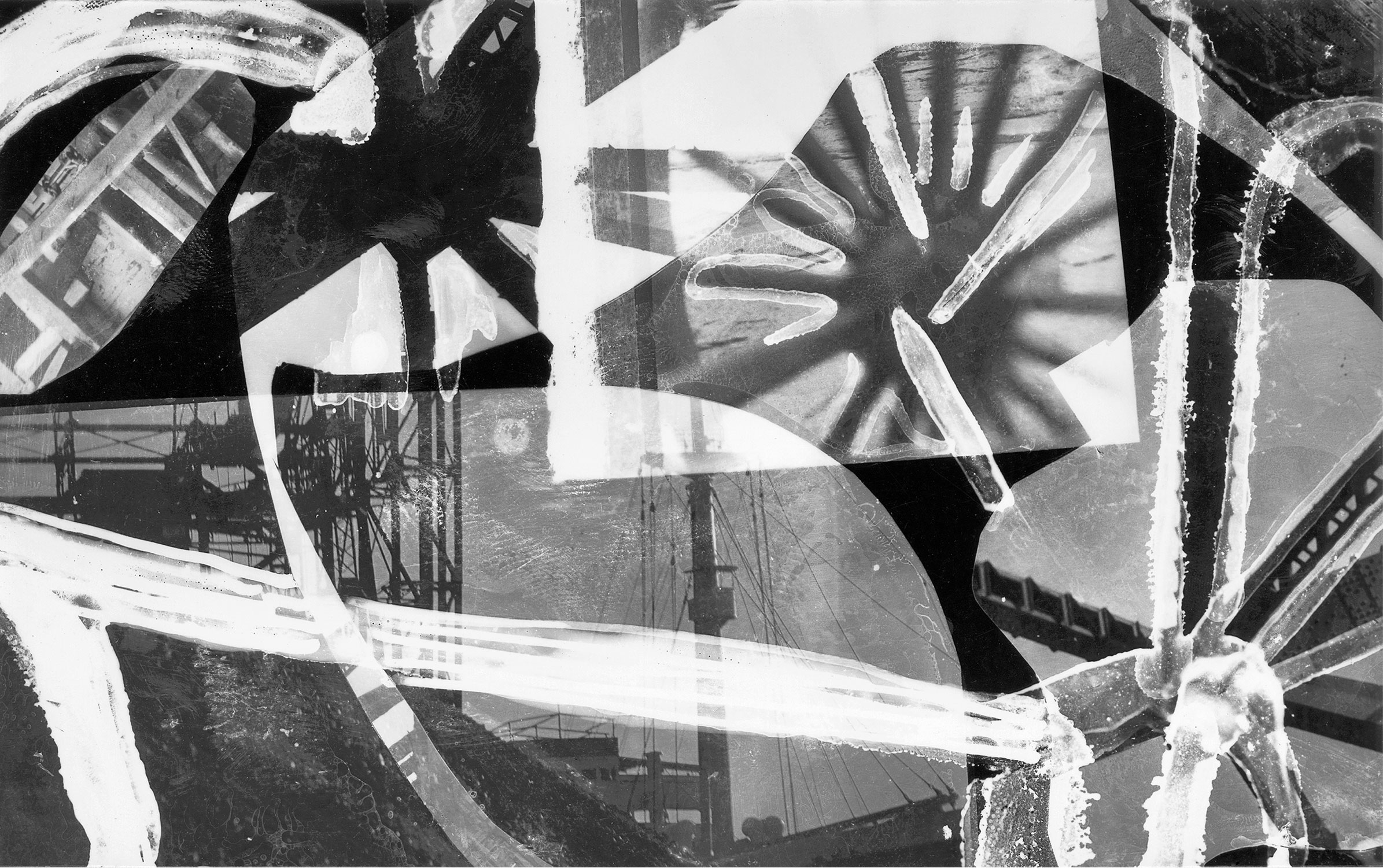
Untitled, c. 1932–35
Chromogenic black-and-white print of photocollage
5 x 8 in. (12.7 x 20.3 cm)
The Estate of David Smith, New York
Smith began making photocollages upon his return to New York from the Virgin Islands in 1932. In order to achieve the layering of shapes, textures, and images seen here, Smith sandwiched multiple negatives together before exposing the photosensitive paper that became the printed photograph. The negatives show evidence of the artist drawing or scraping shapes by hand to achieve lines and textures. The white cutout shapes and lines flatten and confuse foreground and background, echoing later strategic uses of the color white in Smith’s sculptural practice. The image, showing docks in Brooklyn, was likely taken near the Terminal Iron Works, where the artist began his first serious production of welded-steel sculpture. Though Smith would abandon this experimental mode of photography by the mid-1930s, the collage sensibility inherent to this photograph is reminiscent of his later steel and cast sculpture made from multiple found or cut forms.

Untitled (Virgin Islands Tableau), c. 1931–32
Chromogenic black-and-white print, exhibition copy
10 x 5 in. (25.4 x 12.7 cm)
The Estate of David Smith, New York
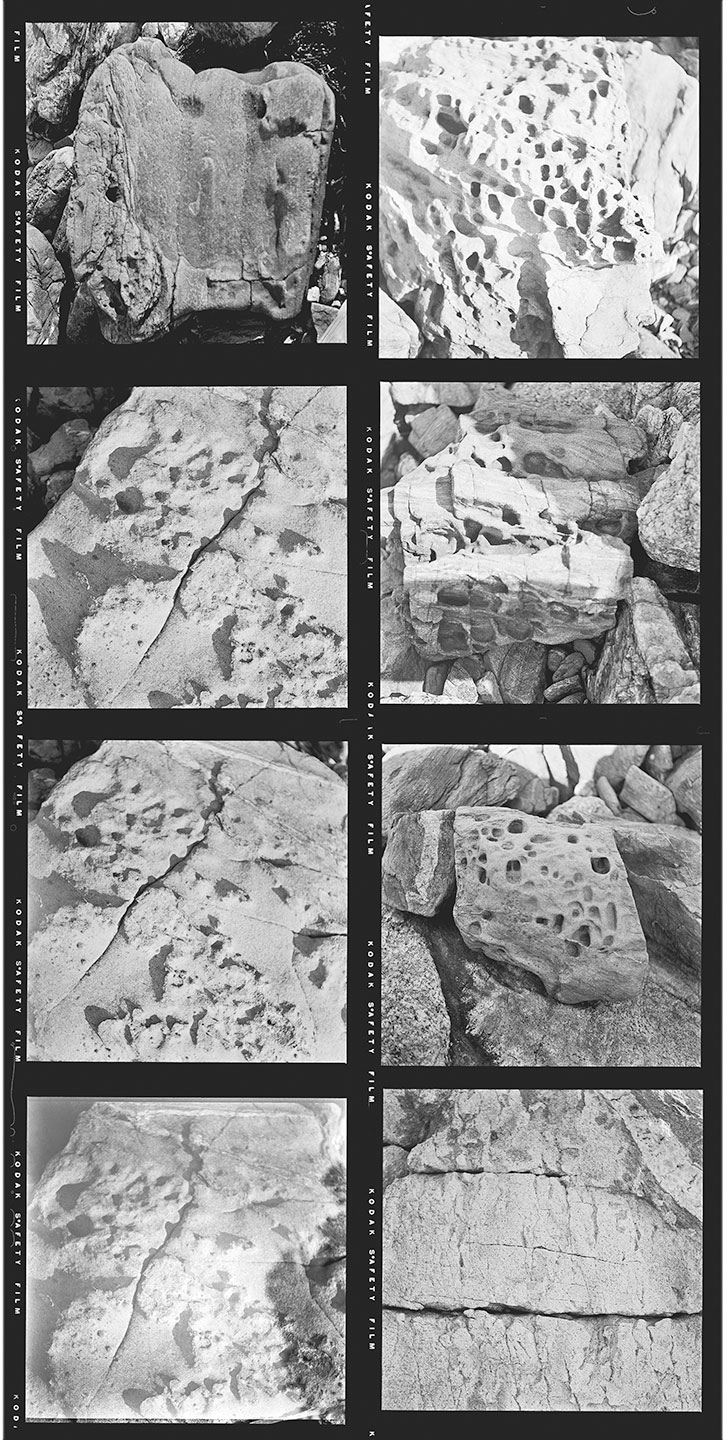
Untitled (Contact Sheet with Close-ups of Rocks), 1931
Chromogenic black-and-white print, exhibition copy
10 x 5 in. (25.4 x 12.7 cm)
The Estate of David Smith, New York
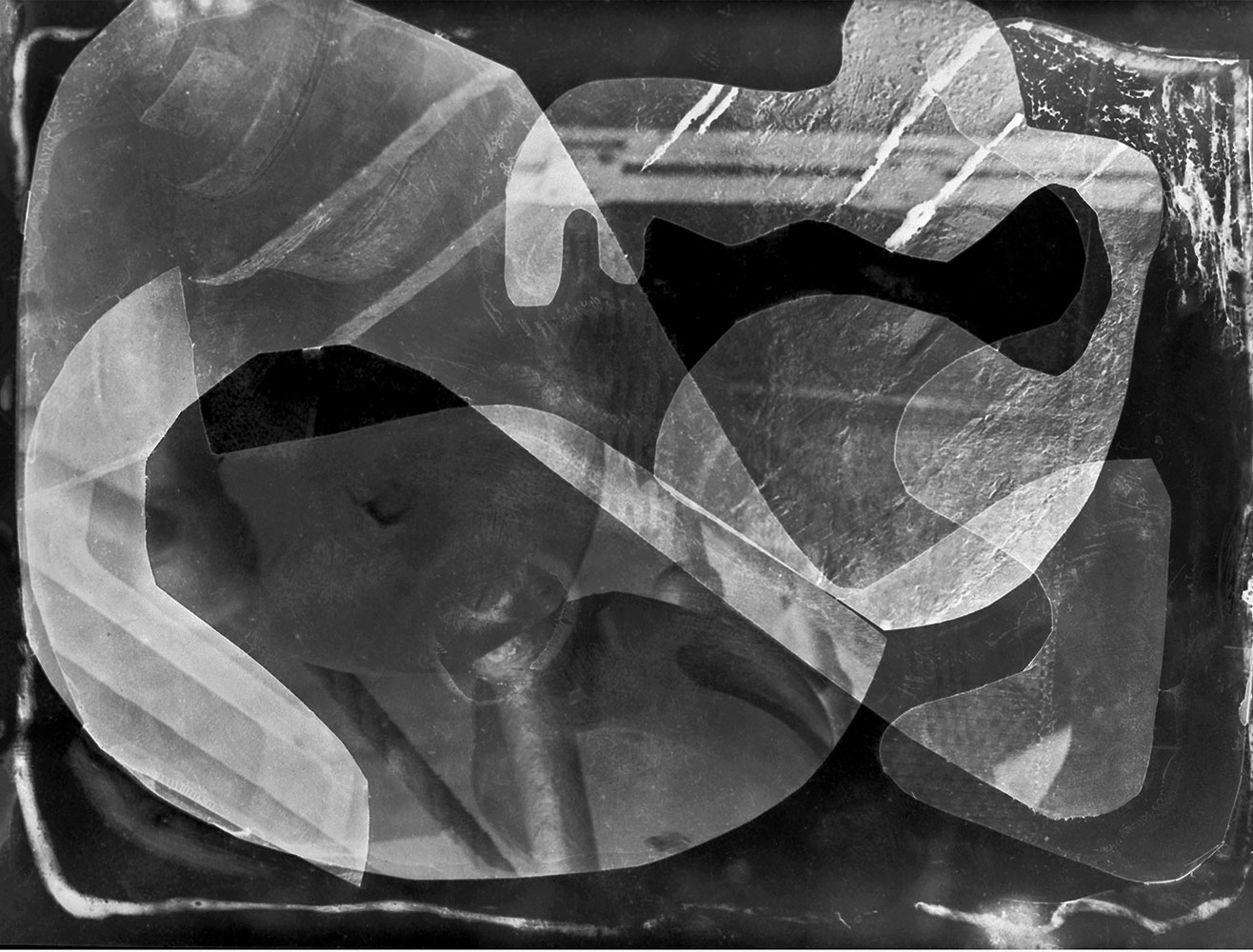
Untitled, c. 1932–35
Chromogenic black-and-white print, exhibition copy
7 x 9 ½ in. (17.8 x 24.1 cm)
The Estate of David Smith, New York
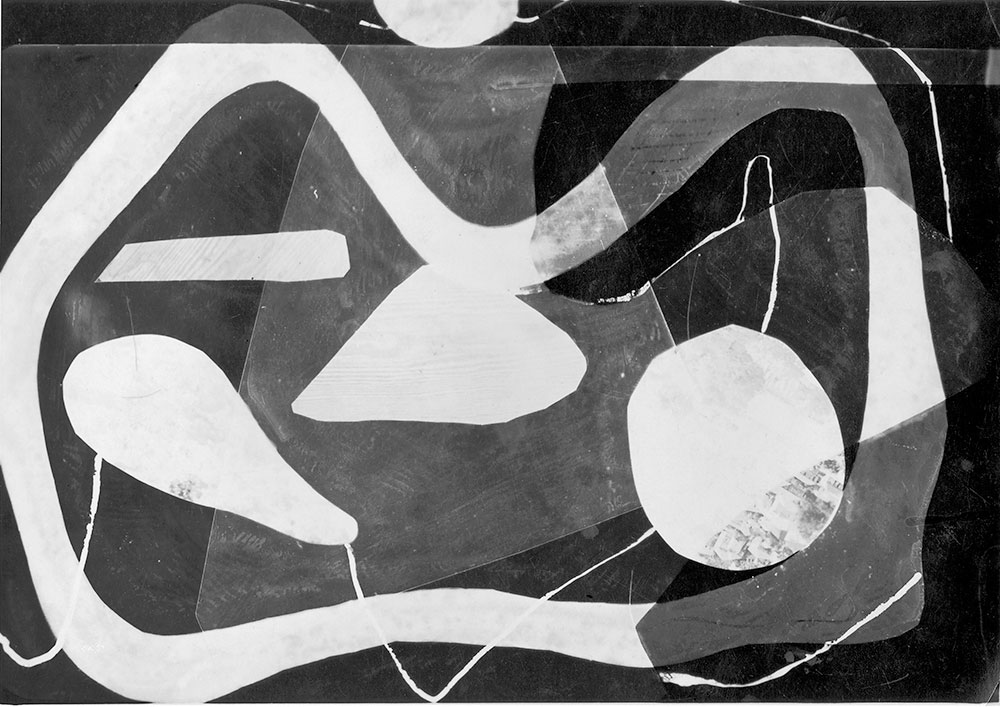
Untitled (Waterlilies), c. 1932–35
Chromogenic black-and-white print of photocollage
9 ½ x 13 in. (24.1 x 33 cm)
The Estate of David Smith, New York
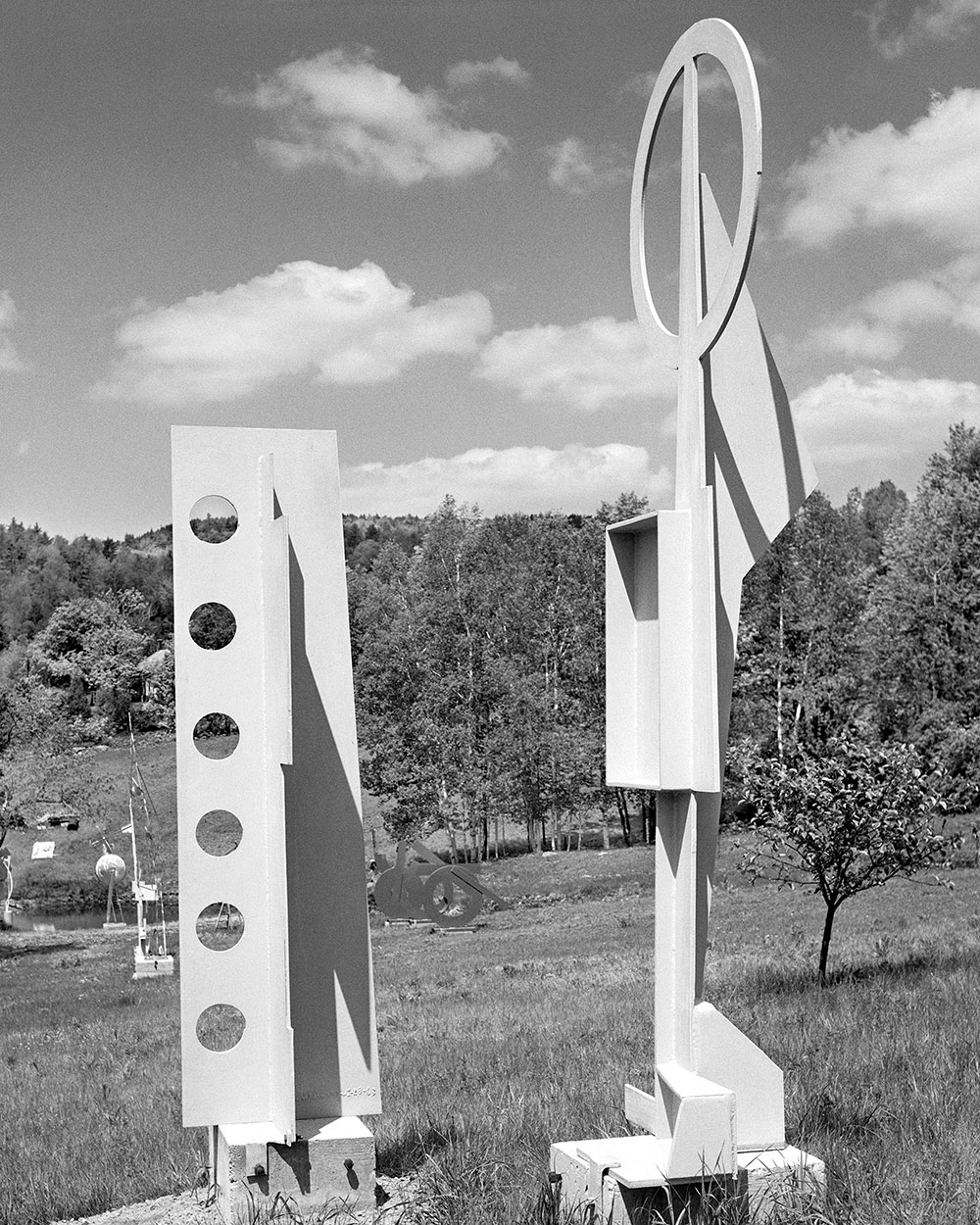
“Circle and Box” with “Untitled 1963” (and Other Works in Background), Bolton Landing, 1963
Chromogenic black-and-white print, exhibition copy
10 x 8 in. (25.4 x 20.3 cm)
The Estate of David Smith, New York
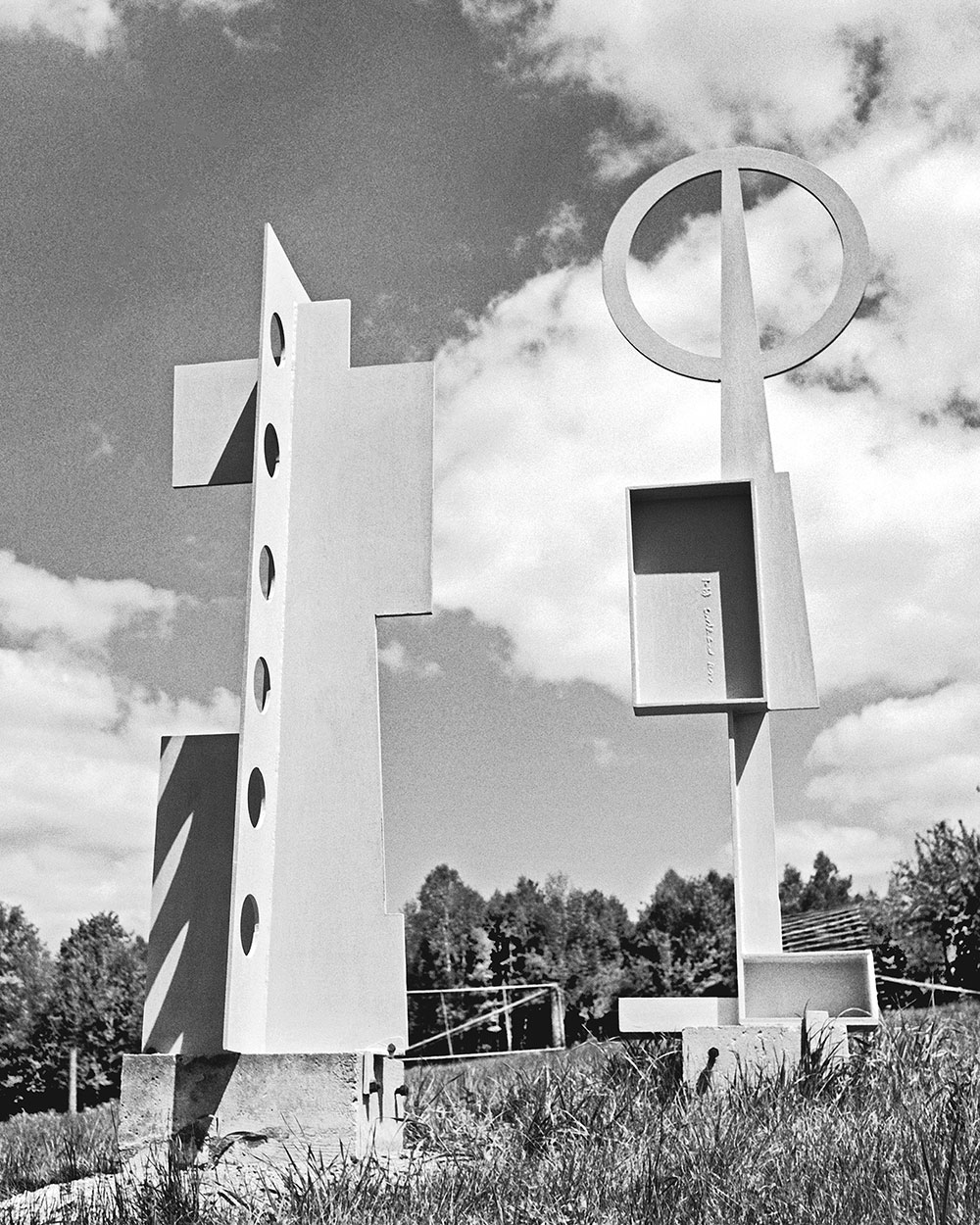
“Circle and Box” with “Untitled 1963”, Bolton Landing, 1963
Chromogenic black-and-white print, exhibition copy
10 x 8 in. (25.4 x 20.3 cm)
The Estate of David Smith, New York
This image exemplifies Smith’s tendency to photograph his sculptures from a “worm’s-eye” view. In addition to suggesting monumentality, this technique of capturing a work from below accentuates the patterns and shapes of the shadows cast by the unique reliefs and planes of the sculptures’ forms. Likewise, photographing from this angle gave Smith the opportunity to align the base of the sculptures with the natural horizon line of the grassy field at Bolton Landing; the monochromatic white surface allows the sculptures to cast geometric shadows, recede into the clouds, and reappear against an open sky—demonstrating Smith’s interest in confusing two- and three-dimensionality. As with many of the photographs Smith took of his sculptures from the mid-1940s onward, this image gives the viewer a snapshot of how the artist understood his own works, untenable forms that change depending on the viewer’s position and the natural setting.
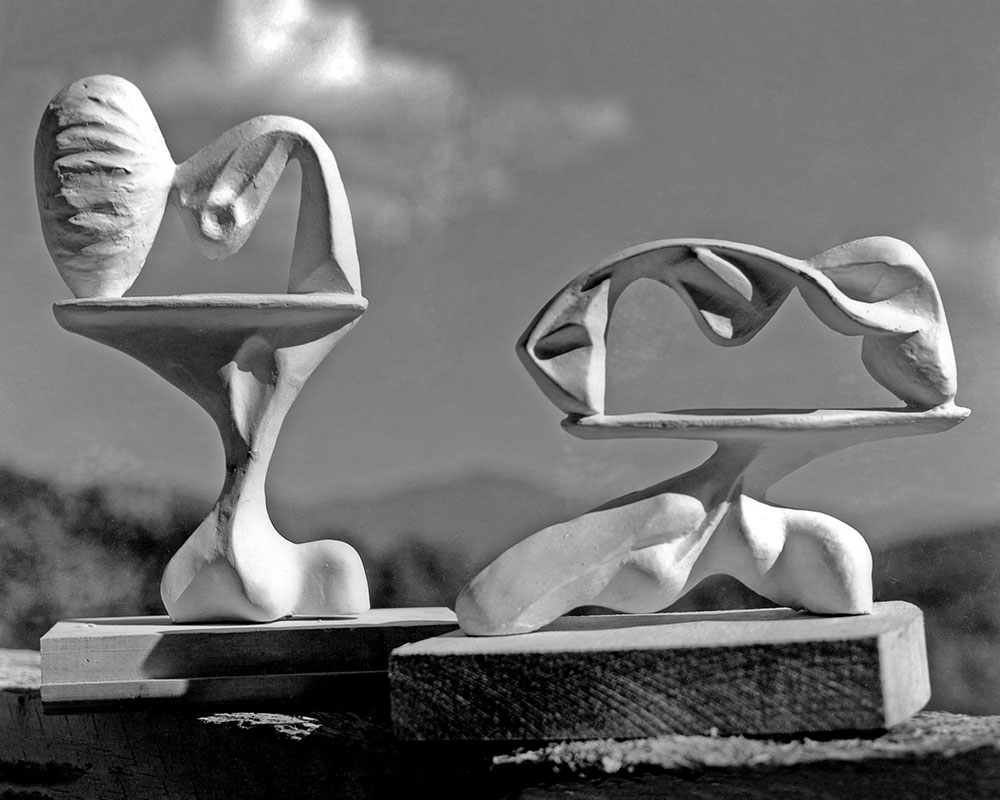
Molds for “Head as Still Life I”, 1942, and “Head as Still Life II” at Bolton Landing, 1942
Chromogenic black-and-white print, exhibition copy
10 x 8 in. (25.4 x 20.3 cm)
The Estate of David Smith, New York
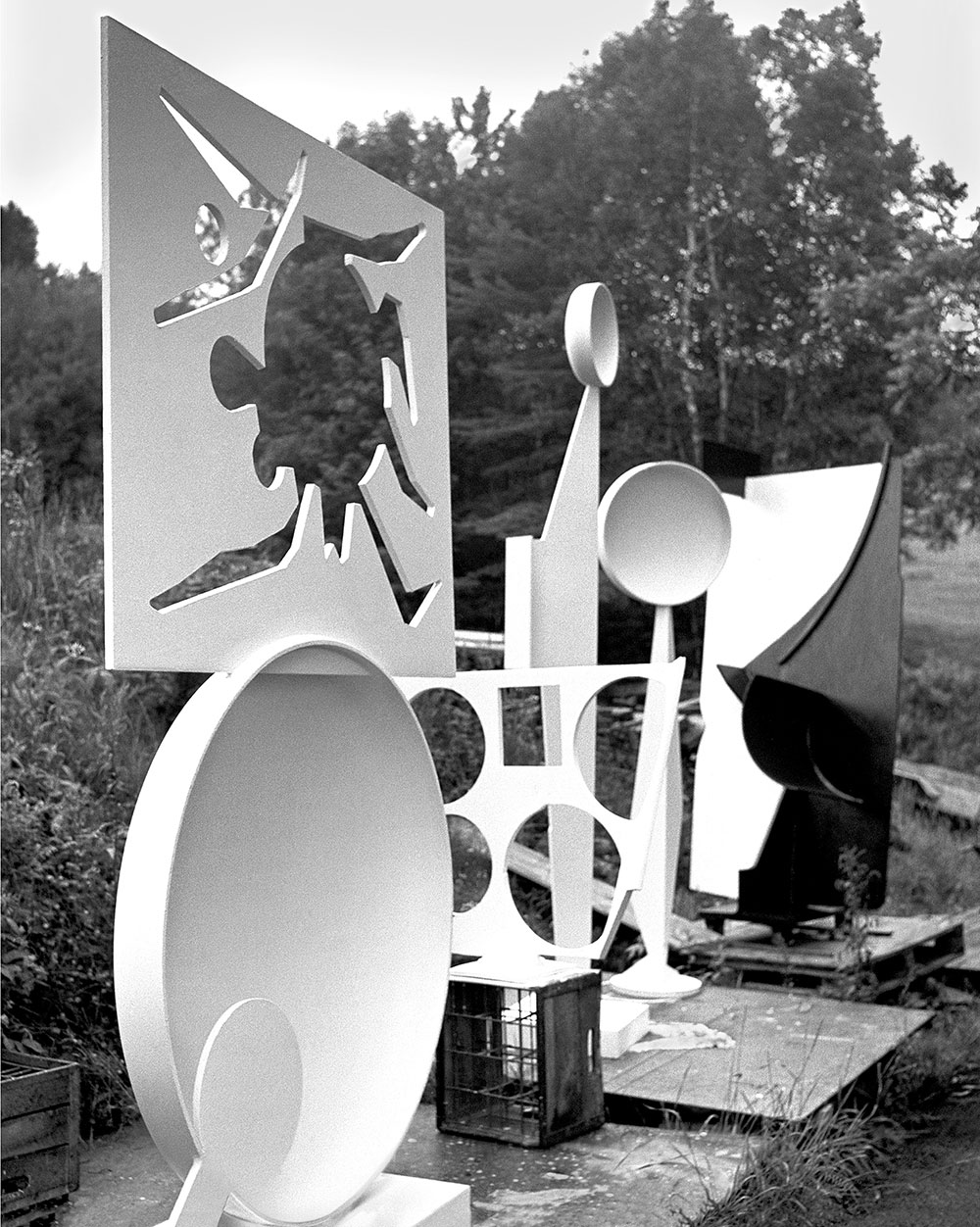
Sculpture Group: Freshly Painted Outside Workshop (Top) and in Workshop (Middle
and Bottom), 1961
Chromogenic black-and-white print, exhibition copy
10 x 8 in. (25.4 x 20.3 cm)
The Estate of David Smith, New York

Group at Bolton Landing with “Primo Piano I”, c. 1963
Chromogenic black-and-white print, exhibition copy
10 x 8 in. (25.4 x 20.3 cm)
The Estate of David Smith, New York
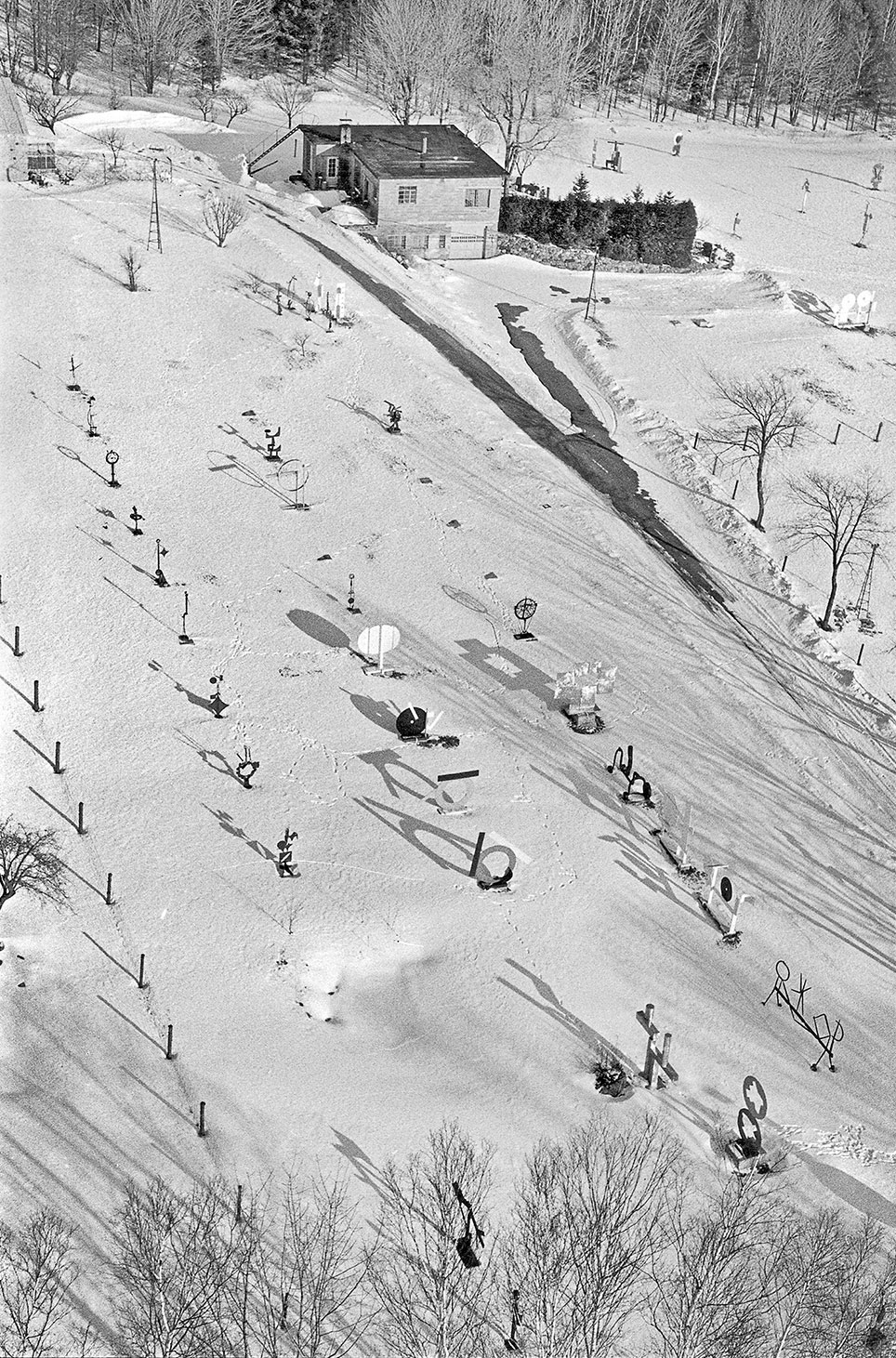
Dan Budnik
American, b. 1933
Bird’s-Eye View of the North Field, David Smith’s Home, and Portion of South Field at Bolton Landing, New York, c. 1962
Chromogenic black-and-white print, exhibition copy
11 x 9 in. (27.9 x 22.9 cm)
The Estate of David Smith, New York
When this photograph was taken, the fields surrounding Smith’s home and studio in Bolton Landing were becoming increasingly populated with sculpture; by the time of his death, in 1965, the artist had placed eighty-nine sculptures outdoors. Photographer Dan Budnik went to Bolton Landing in December 1962, the first of many visits he would pay to Smith’s remote home. In this aerial view, Budnik demonstrates how Smith methodically installed works along a grid. He would later recall, “Images of David stick with me. . . . My contact sheets are alive with his thoughts; his work exudes life. He showed me his fields of sculpture and shared his vision too.” The photographs that followed Budnik’s visit to Bolton Landing have become some of the most iconic images of Smith in his studio.
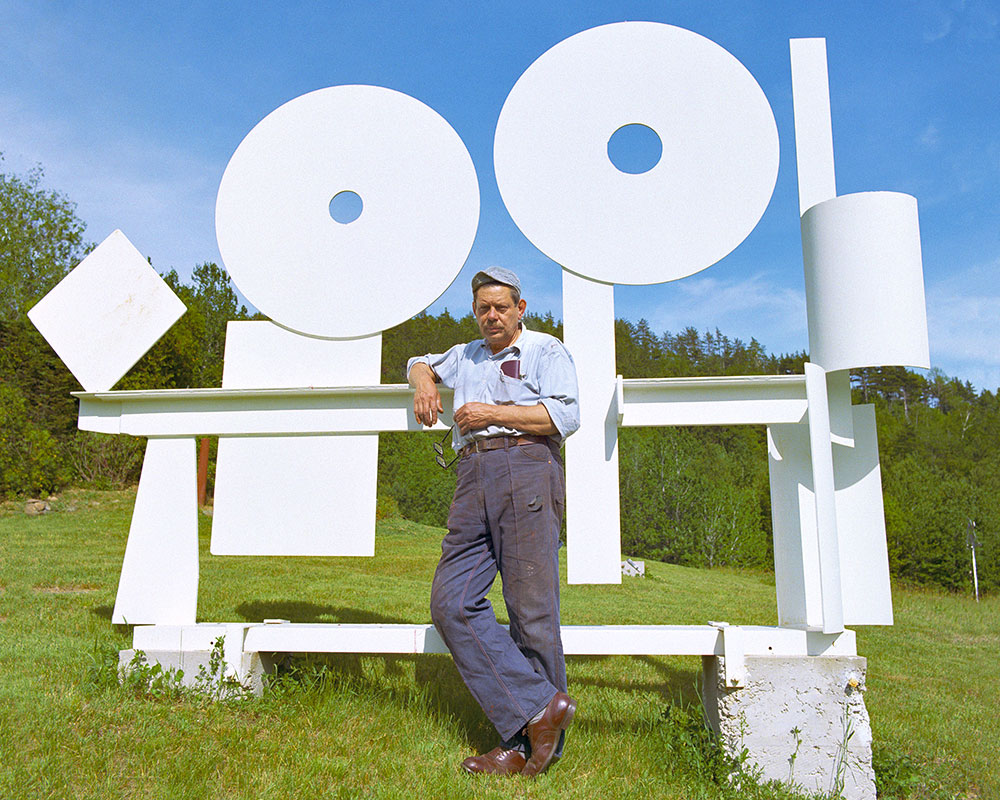
Unknown photographer
Portrait of David Smith with “Primo Piano I”, 1962
Chromogenic color print, exhibition copy
8 x 10 in. (20.3 x 25.4 cm)
The Estate of David Smith, New York

Albany I, 1959
Painted steel
25 x 25 3/4 x 7 1/4 in. (63.5 x 65.4 x 18.4 cm)
Gift of the Ralph E. Ogden Foundation

Becca, 1964
Steel
78 x 47 1/2 x 23 1/2 in. (198.1 x 120.7 x 59.7 cm)
Gift of the Ralph E. Ogden Foundation
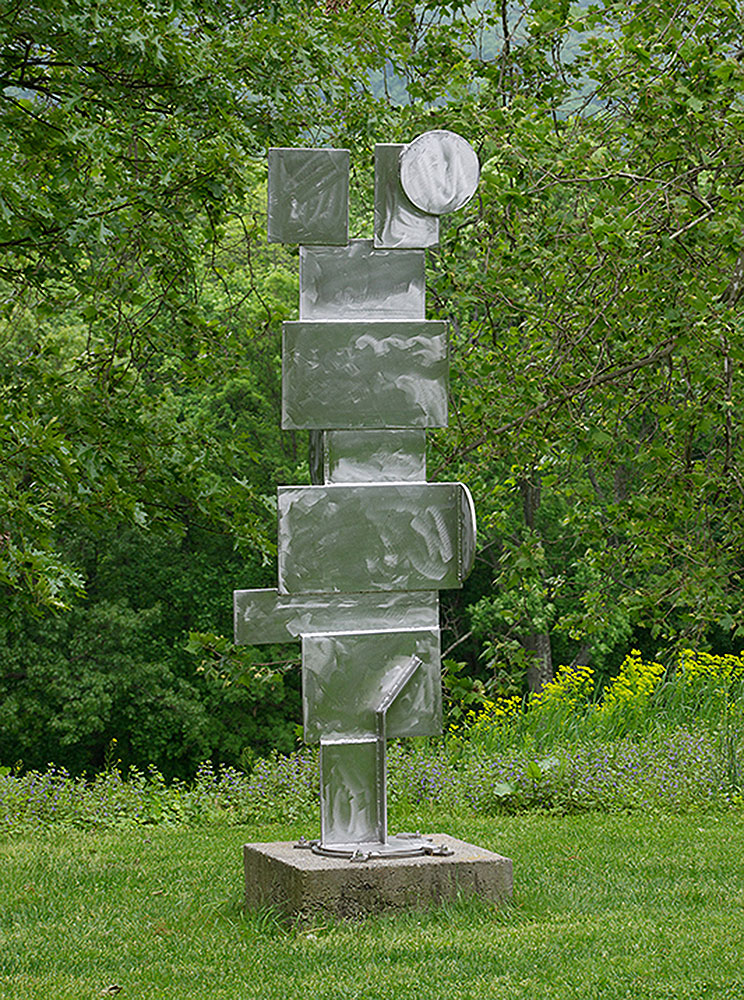
XI Books III Apples, 1959
Stainless Steel
94 x 35 x 16 1/4 in. (238.8 x 88.9 x 41.3 cm)
Gift of the Ralph E. Ogden Foundation
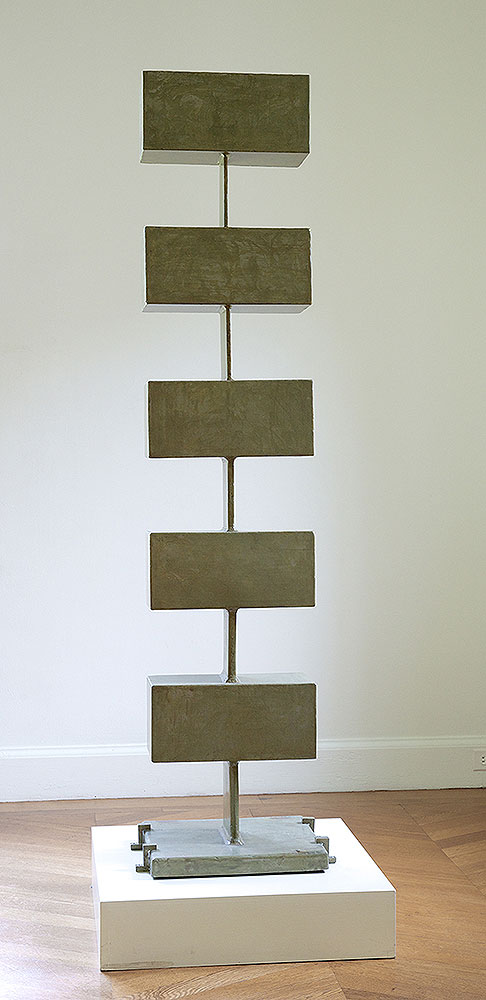
Five Units Equal, 1956
Painted Steel
73 1/3 x 16 x 14 in. (186.3 x 40.6 x 35.6 cm)
Gift of the Ralph E. Ogden Foundation

The Iron Woman, 1954-58
Painted Steel
88 1/4 x 14 1/3 x 16 in. (224.2 x 36.4 x 40.6 cm)
Gift of the Ralph E. Ogden Foundation
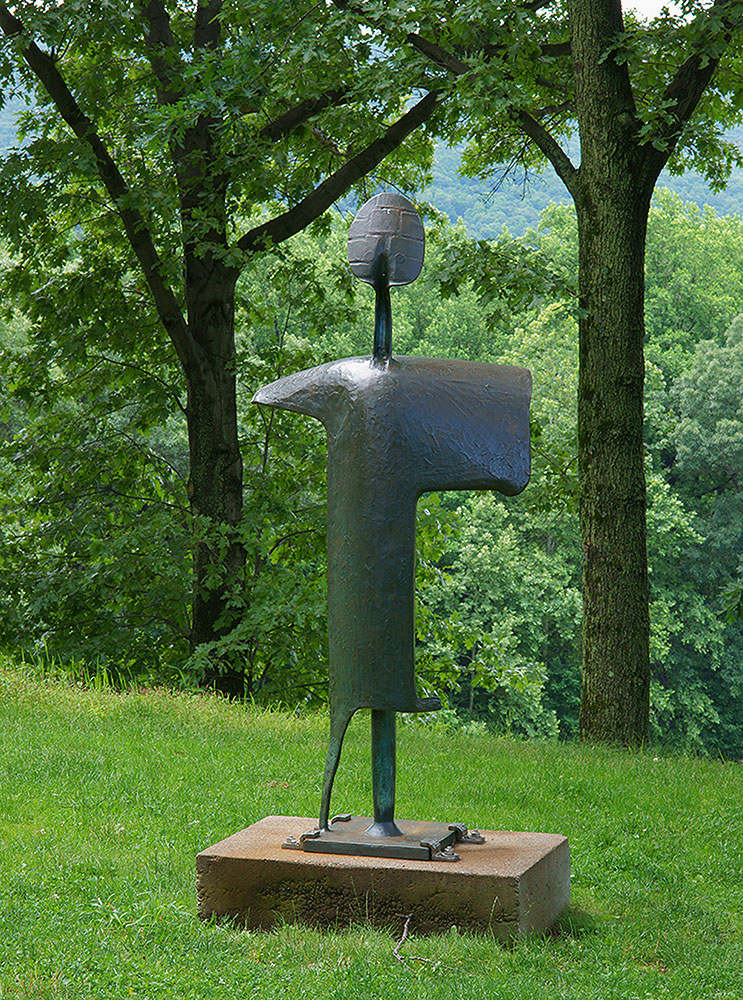
Personage of May, 1957
Bronze
71 5/8 x 31 1/2 x 18 1/2 in. (181.9 x 80 x 47 cm)
Gift of the Ralph E. Ogden Foundation
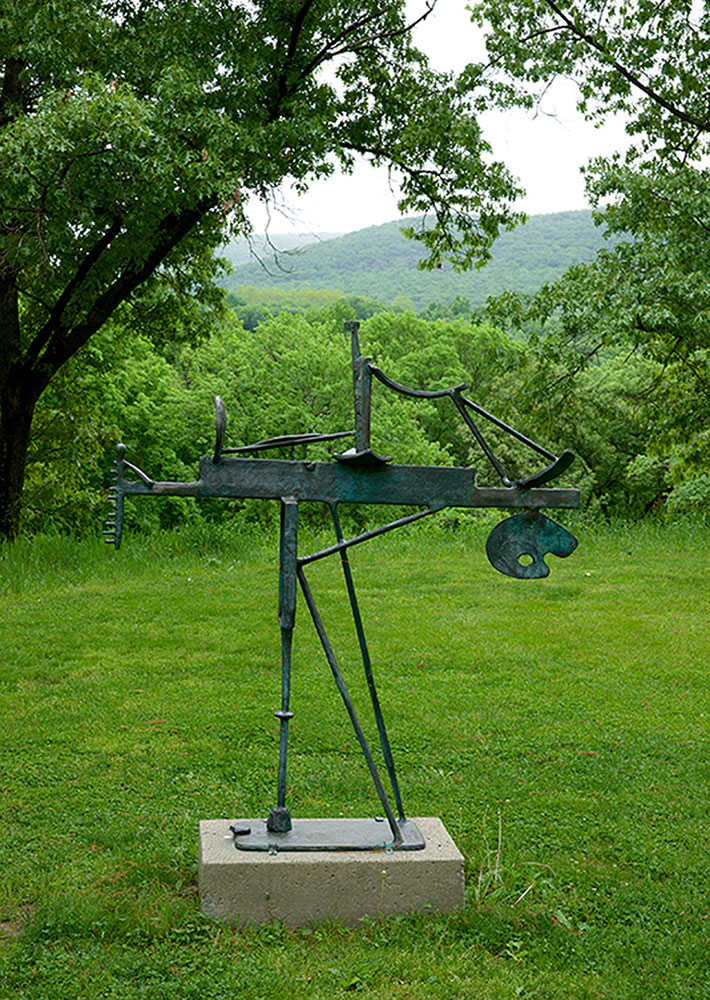
Portrait of a Lady Painter, 1954/1956–57
Bronze
64 x 59 3/4 x 12 1/2 in. (162.6 x 151.8 x 31.8 cm)
Gift of the Ralph E. Ogden Foundation

Raven V, 1959
Steel and stainless steel
59 x 55 x 11 in. (149.9 x 139.7 x 28 cm)
Gift of the Ralph E. Ogden Foundation

The Sitting Printer, 1954-55
Bronze
87 x 15 3/4 x 17 in. (221 x 40 x 43.2 cm)
Gift of the Ralph E. Ogden Foundation
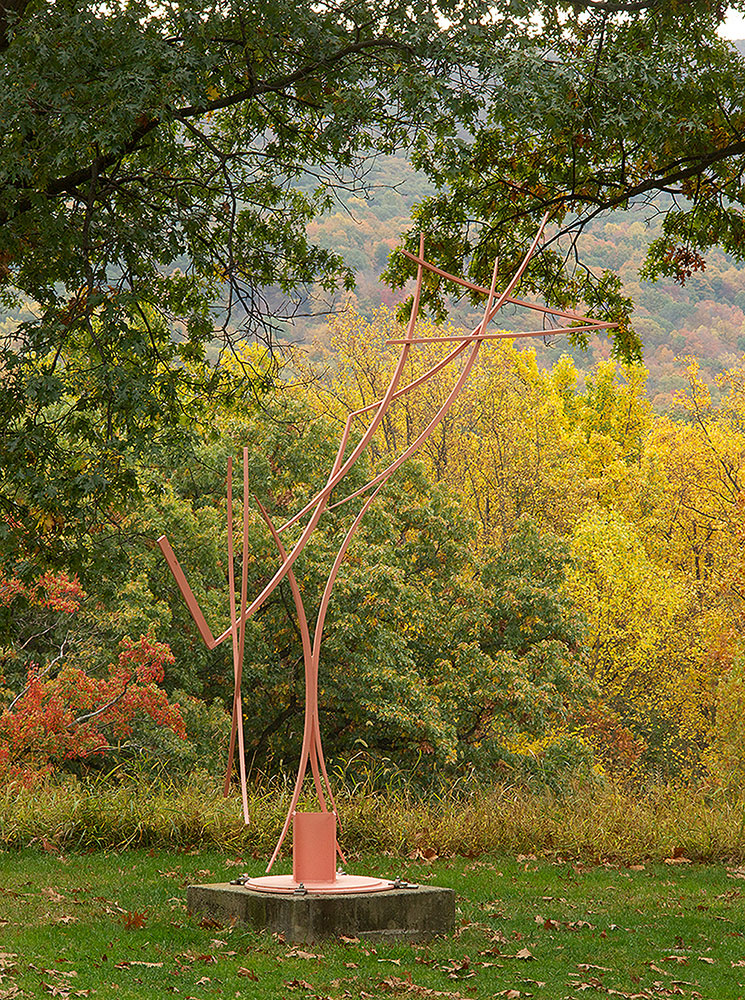
Study in Arcs, 1957
Painted steel
121 x 114 1/2 x 36 1/2 in. (307.3 x 290.8 x 92.7 cm)
Gift of the Ralph E. Ogden Foundation

